Sapphire Nitro+ Radeon RX 6650 XT, 6750 XT, and 6950 XT Pure review

 Image: Brad Chacos/IDG
Image: Brad Chacos/IDG At a glance
At a glance
Expert’s Rating
Pros
Chart-topping performance in many gamesRadeon Super Resolution and Smart Access Memory make it even fasterMuch cheaper than Nvidia’s rival RTX 3090Gorgeous all-white aesthetic and high-quality componentsIncredibly cool and quietDual BIOS switch and idle fan stop
Cons
Massive 3.5 slot designVery expensive, poor price-to-performance compared to Radeon RX 6800 XTPower hungryRay tracing performance lags behind Nvidia RTX GPUs
Our Verdict
The Sapphire Nitro+ Pure Radeon RX 6950 XT is a cool, quiet, gorgeous beast pushed even further by AMD’s Smart Access Memory and Radeon Super Resolution features—if you can afford it, fit it in your case, and feed its deep thirst for power.
Price When Reviewed
$1249
Best Prices Today: Nitro+ Pure Radeon RX 6950 XT
RetailerPrice
After two long, bleak years of heartbreak, graphics cards are finally starting to become available at suggested prices (sometimes), right as Intel winds up to deliver its debut Arc discrete desktop graphics cards this summer. The winds of change are finally blowing, and AMD decided this is the perfect time to roll out a “refresh” of several Radeon RX 6000-series graphics cards. Today, we’re reviewing the $399 Radeon RX 6650 XT, $549 Radeon RX 6750 XT, and $1,099 Radeon RX 6950 XT.
Each sports the same underlying GPU specs as their vanilla counterparts (the Radeon RX 6600 XT, 6700 XT, and 6900 XT, respectively), but with faster memory and both clock speeds and power draw juiced.
Is that enough to jockey AMD’s latest offerings into pole positions on our roundup of the best graphics cards and justify their higher price tags? To find out, we look to Sapphire’s swanky Nitro+ versions of each model—including the stunning new whited-out Nitro+ “Pure” Radeon RX 6950 XT, a premium piece of kit that aims to take down Nvidia’s vaunted RTX 3090. Let’s dig in.
Editor’s note: Our content system only allows for one scored review per article. The Nitro+ Radeon RX 6650 XT and Nitro+ 6750 XT would get 3.5 stars—3 for AMD’s underlying GPU performance, and an extra half star for Sapphire’s sublime Nitro+ design and implementation.
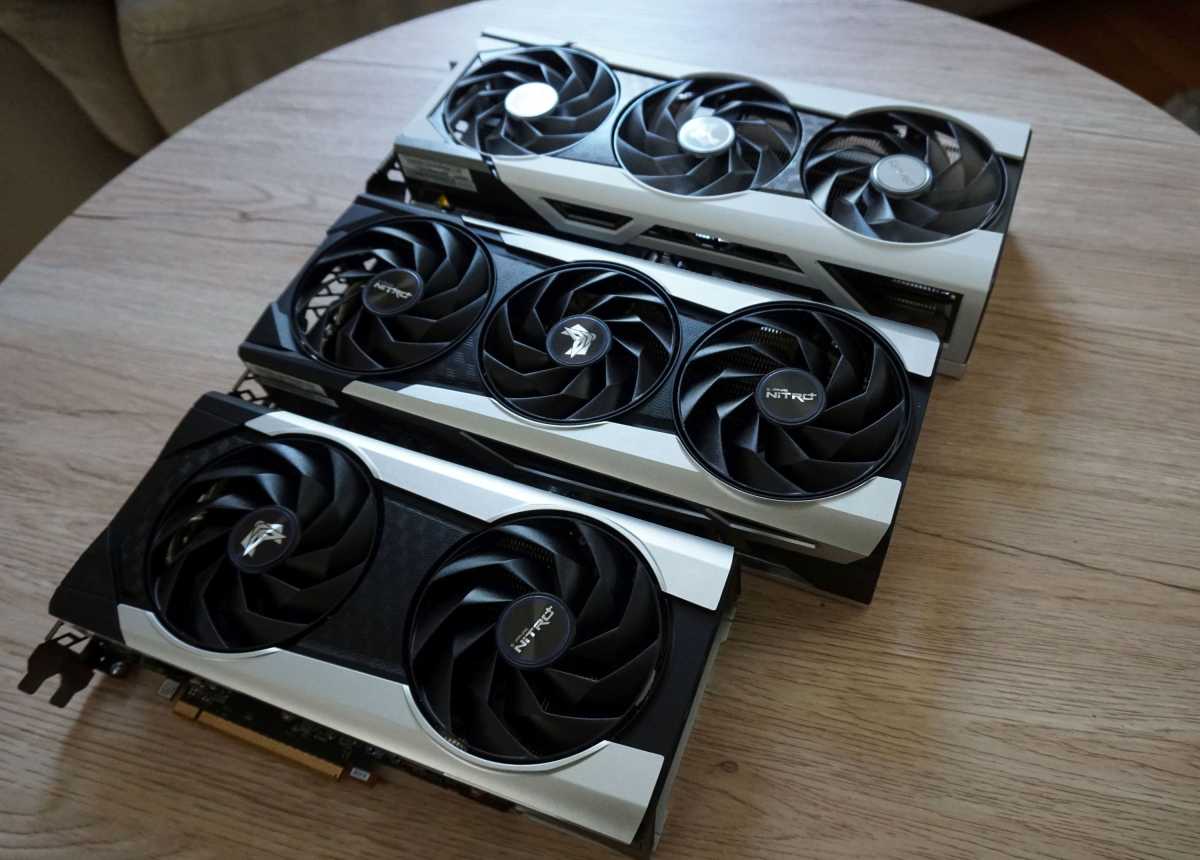
The Sapphire Nitro+ Radeon RX 6650 XT, 6750 XT, and Nitro+ Pure RX 6950 XT
The Sapphire Nitro+ Radeon RX 6650 XT, 6750 XT, and Nitro+ Pure RX 6950 XT
Brad Chacos/IDG
The Sapphire Nitro+ Radeon RX 6650 XT, 6750 XT, and Nitro+ Pure RX 6950 XT
Brad Chacos/IDG
Brad Chacos/IDG
AMD Radeon RX “6×50” specs and features
The refreshed Radeon RX “6×50” GPUs don’t reinvent the wheel. Instead, they amplify the already-capable power of the vanilla versions, pushing the potential of AMD’s killer RDNA 2 architecture to its limits. The Radeon RX 6650 XT, 6750 XT, and 6950 XT all come with dedicated hardware for real-time ray tracing, a radical new on-die “Infinity Cache” that helps speed up gaming performance, AV1 decoding (though not encoding), and more.
Here’s an AMD-supplied look at the technical details for the reference designs:

AMD
AMD
AMD
AMD’s chart doesn’t compare the refreshes against the originals, but there are several key (minor) differences to be aware of:
The Radeon RX 6650 XT has an average Game GPU clock of 2,410MHz and a Boost clock of 2,635MHz, up from 2,359MHz and 2,589MHz, respectively, in the 6600 XT. It also received a memory speed bump, from 16Gbps to 17.5Gbps. The total board power draw went up to accommodate those tweaks, going from 160W in the 6600 XT to 180W in the 6650 XT.The Radeon RX 6750 XT has an average Game GPU clock of 2,495MHz and a Boost clock of 2,600MHz, up from 2,424MHz and 2,581MHz, respectively. It also received a memory speed bump, from 16Gbps to 18Gbps, and the total board power draw increases from 230W in the vanilla 6700 XT to 250W in the 6750 XT.The Radeon RX 6750 XT has an average Game GPU clock of 2,100MHz and a Boost clock of 2,310MHz, up from 2,015MHz and 2,250MHz, respectively. Its memory speed also increased from 16Gbps to 18Gbps. Making those speed increases on such a big, badass GPU doesn’t come easily though; this card sees the most significant total board power draw increases of all, going from 300W in the vanilla 6900 XT to 335W in the 6950 XT.
The Sapphire Nitro+ versions we’re reviewing come factory overclocked with even higher speeds, which we’ll detail in the next section. The memory and core clock speed boosts indeed result in faster performance, though as you’ll see in our benchmark section, they’re fairly modest increases. This Radeon RX 6×50 refresh is about evolution, not revolution. Don’t expect to see Team Red suddenly shoot past Nvidia’s best-in-class ray tracing performance with these.
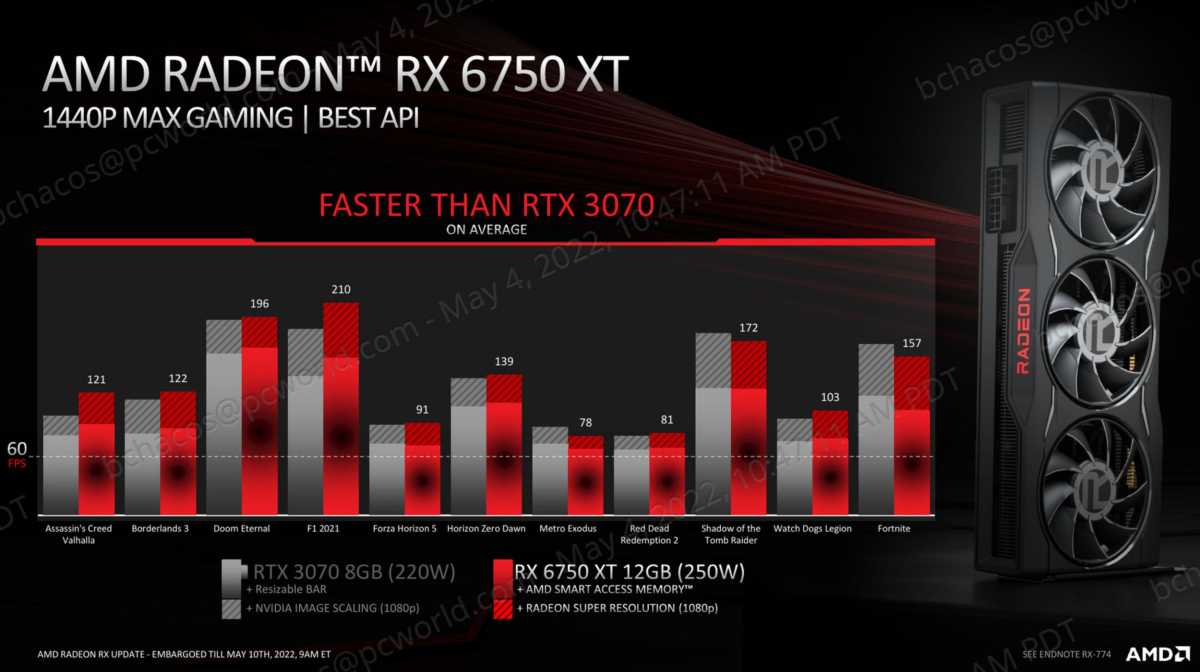
Activating Smart Access Memory and Radeon Super Resolution gives AMD’s graphics cards a massive performance boost.
Activating Smart Access Memory and Radeon Super Resolution gives AMD’s graphics cards a massive performance boost.
AMD
Activating Smart Access Memory and Radeon Super Resolution gives AMD’s graphics cards a massive performance boost.
AMD
AMD
More exciting events are happening on the software side of things. AMD has been diligently deploying new software features over RDNA’s lifetime, and its recently released Radeon Super Resolution (RSR) feature can greatly enhance frame rates in virtually any game, using the power of upscaling. The company’s Smart Access Memory (SAM) feature, which lets Ryzen CPUs talk directly to the GPU’s onboard memory, can also supercharge performance in some games, though it’s very resolution- and settings-specific. SAM is much more effective than Nvidia and Intel’s rival PCIe Resizable BAR support.
In tandem, RSR and SAM can send performance through the roof, and they’re a big part of AMD’s value proposition with these new GPUs, though both come with some minor caveats. We’ll briefly wade into that after our standard benchmark section.
While most Radeon 6×50 cards will ship in third-party custom versions, AMD will also ship reference designs for the Radeon RX 6750 XT and 6950 XT through its website. The company will also be retiring the original 6600 XT in favor of the newer, more expensive 6650 XT, though all other AMD Radeon RX 6000-series GPUs “will continue to run their natural course based on market demand,” an AMD spokesperson tells me.
Meet Sapphire’s Nitro+
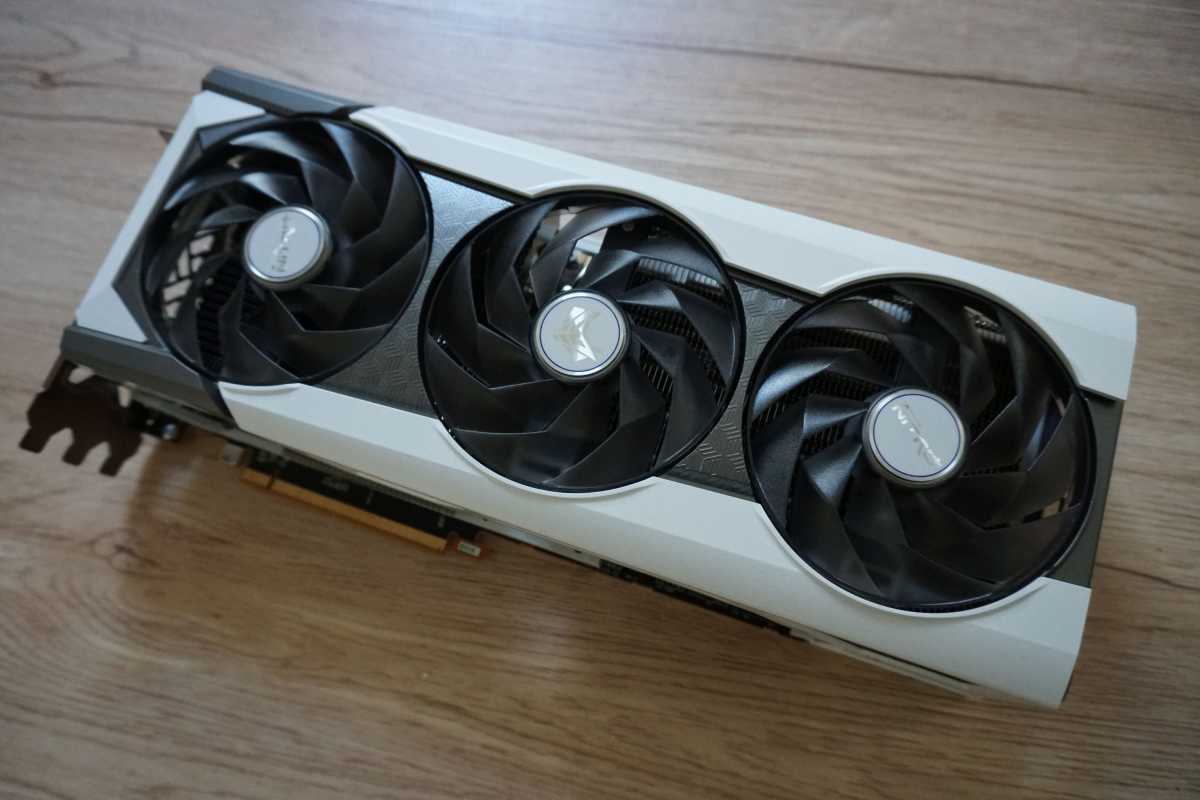
The Sapphire Nitro+ Pure RX 6950 XT
The Sapphire Nitro+ Pure RX 6950 XT
Brad Chacos/IDG
The Sapphire Nitro+ Pure RX 6950 XT
Brad Chacos/IDG
Brad Chacos/IDG
Sapphire sent over one of each new GPU to test, all hailing from the company’s vaunted Nitro+ lineup, which targets enthusiasts more than Sapphire’s mainstream Pulse lineup. We received the $449 Nitro+ Radeon RX 6650 XT, $619 Nitro+ Radeon RX 6750 XT, and the gorgeous $1,249 Nitro+ “Pure” Radeon RX 6950 XT, which sports a new cooler design with a slick, imposing all-white aesthetic. The 6650 XT and 6750 XT stick to Sapphire’s established, eye-catching cyberpunk-esque design.
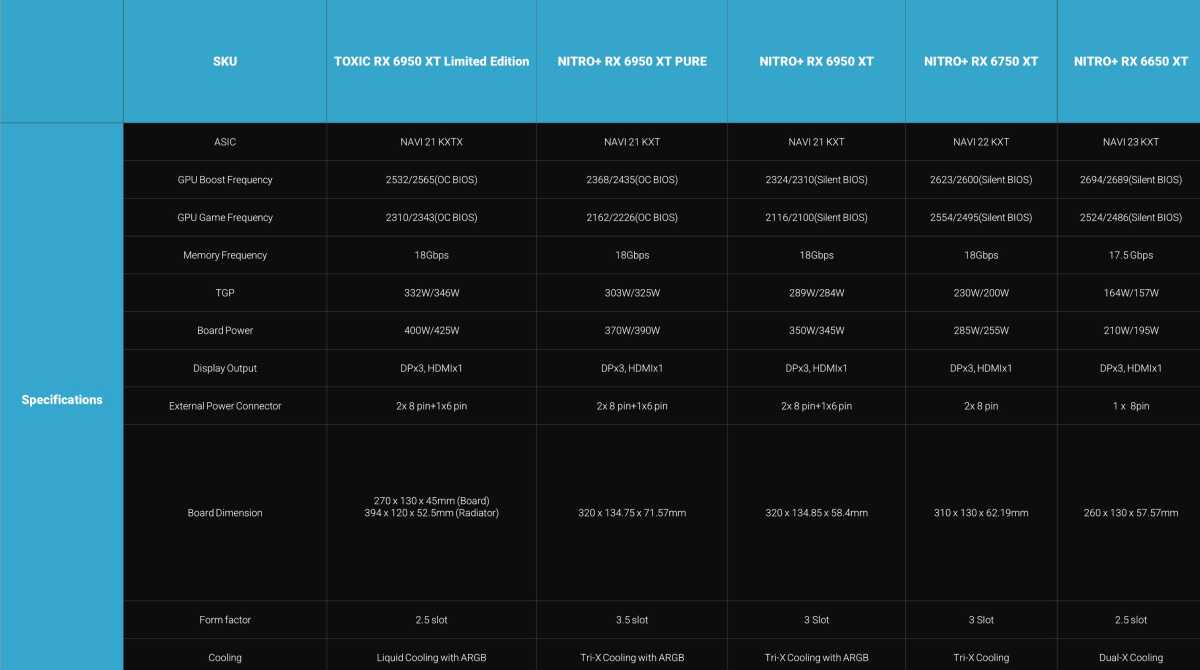
Sapphire
Sapphire
Sapphire
All three sport Sapphire’s “wave fin” heat sink design, engineered to reduce air friction (and thus noise), and a V-shaped notch in the heat sink directly over the GPU itself to “accelerate and centralize the air flow” in a quest to dissipate heat more effectively. Varying amounts of composite heat pipes snake through each—you’ll find more in the more expensive models—but every Nitro+ comes with a standalone memory/VRM cooling module that tames the MOSFETS and chokes alike, while the Nitro+ Pure RX 6950 XT includes a die-cast aluminum-magnesium alloy frame to ensure the card is rigid enough to hold all these fancy cooling components.

Sapphire
Sapphire
Sapphire
Sapphire also equipped these 6×50 Nitros with new, second-generation “angular velocity” hybrid fans that merge characteristics from both axial and blower-style fans, improving airflow and air pressure compared to yesteryear’s axial fans while keeping noise levels low. This second-gen iteration improves air pressure and amount by 44 and 19 percent, respectively, Sapphire says. The Nitro+ 6750 XT and Nitro+ Pure 6950 XT each come with three fans embedded in their shrouds, while the Nitro+ 6650 XT packs two. All three feature idle fan stop, which turns off the fans completely if you aren’t gaming or performing other GPU-intensive tasks. Those fans can be quickly replaced if they break using Sapphire’s Quick Connect Fan feature.
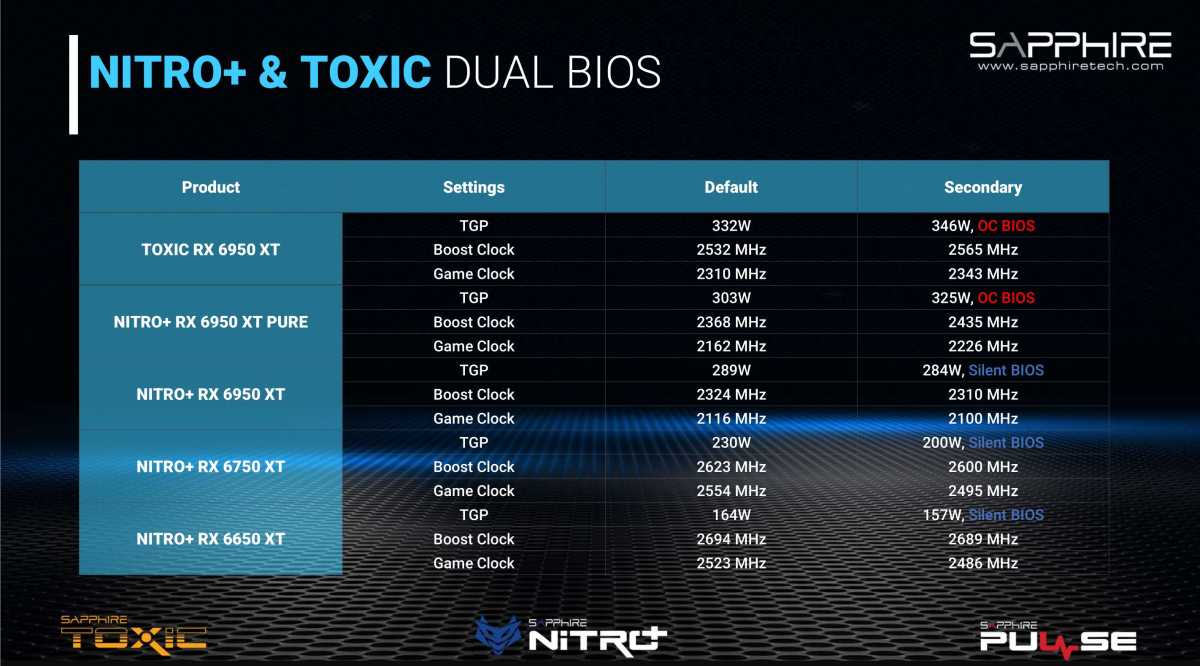
Sapphire
Sapphire
Sapphire
The Nitro+ series is known for its quiet, cool performance, and these 6×50 refreshes are no exception. These enthusiast-focused cards also come with dual-BIOS switches helpful for overclocking endeavors, though the default performance for the secondary BIOS differs between the Nitro+ 6650 XT and the higher-end models. The 6650 XT’s secondary setting is a “silent BIOS” that slightly reduces power draw and clock speeds to run even quieter than the default whisper. The 6750 XT and Nitro+ Pure 6950 XT, on the other hand, come with a secondary “OC BIOS” that amps up the power draw and clock speeds if you want to put the pedal to the metal.
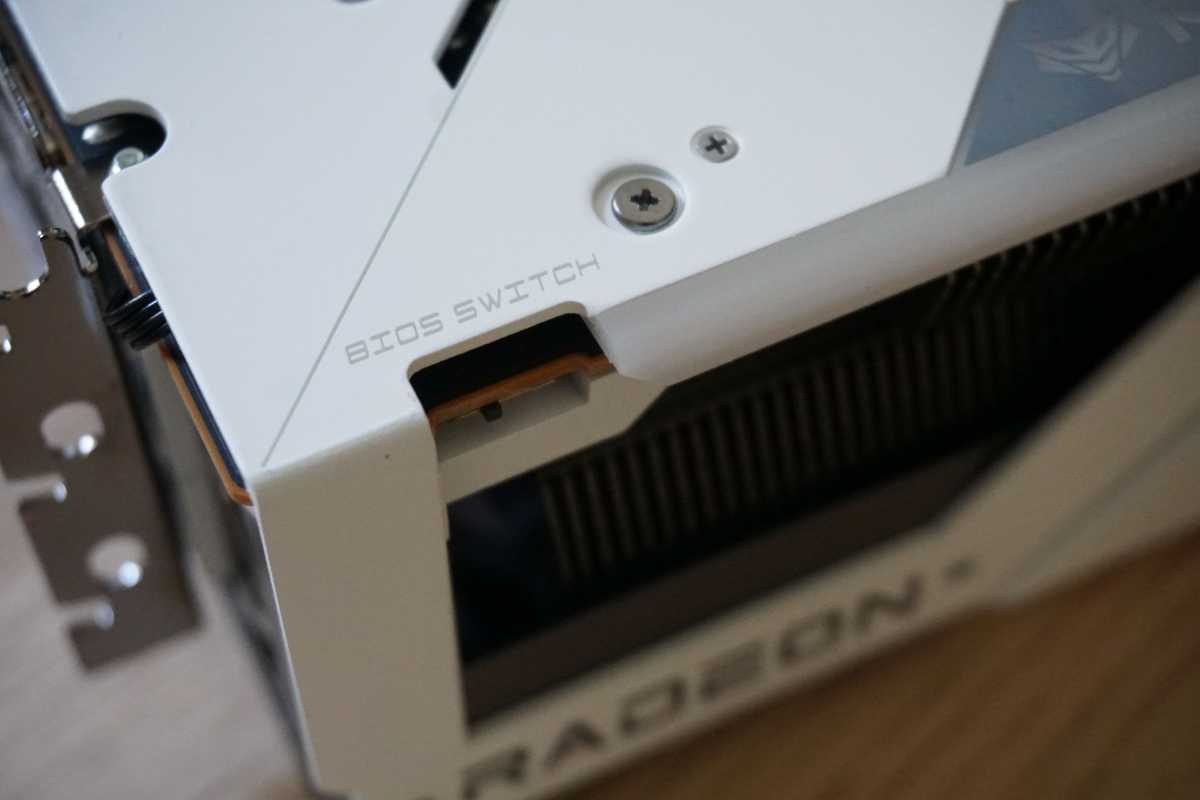
Brad Chacos/IDG
Brad Chacos/IDG
Brad Chacos/IDG
Sapphire’s Trixx software utility can be used to shift between the two BIOSes without needing to rip open your PC and flip the physical switch. Trixx can also adjust the look of the Nitro+ cards’ RGB lighting, and check their fan health. The software suite also gives you access to Trixx Boost, a performance-boosting feature that won the 2019 innovation award on our Full Nerd podcast. Unfortunately for Sapphire, the introduction of AMD’s Radeon Super Resolution largely eliminates Trixx Boost’s usefulness, though you can still use Sapphire’s feature to craft custom monitor resolutions that give you greater control over how Radeon Super Resolution behaves.

Brad Chacos/IDG
Brad Chacos/IDG
Brad Chacos/IDG

Brad Chacos/IDG
Brad Chacos/IDG
Brad Chacos/IDG
These are all very impressive pieces of kit. But before we move on to testing, I want to highlight just how stunning the new Nitro+ Pure design is. The huge, white card looks so fresh and so clean, and runs utterly silent. Subtle RGB lights in the fans and embedded in the aluminum backplate help it look even better. My teenage daughter has grown up with me benchmarking endless graphics cards, but this is the first card to ever make her stop and ask, “Whoa, what is that?” when she walked in during my testing.
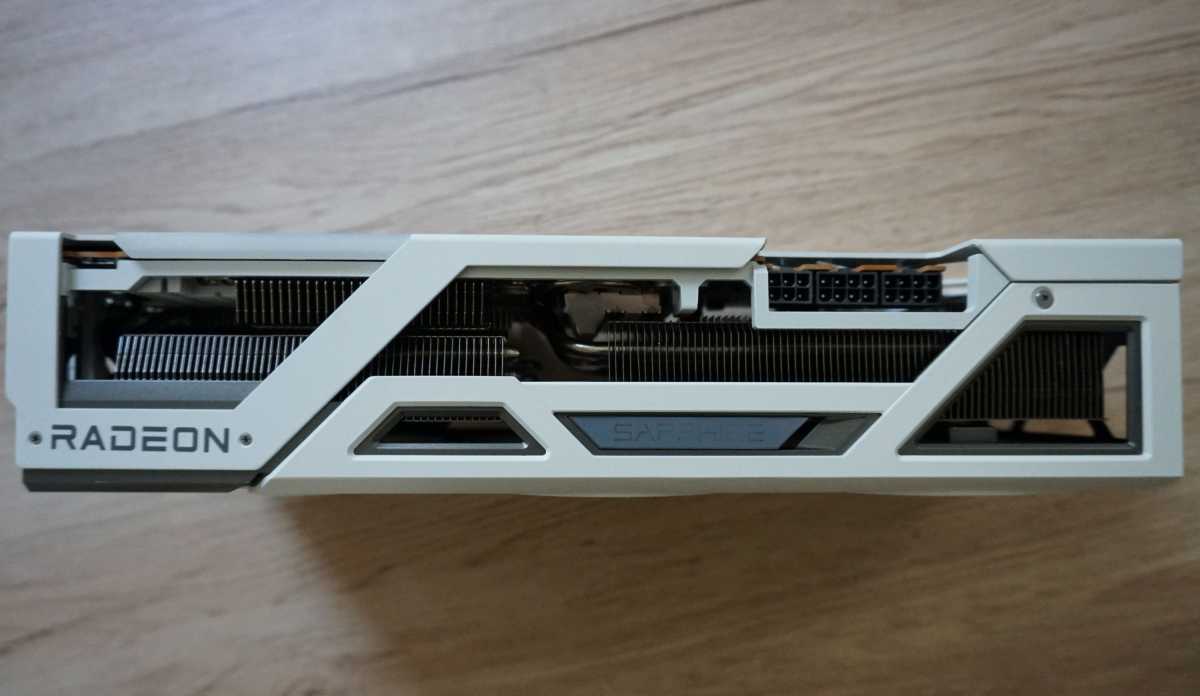
Brad Chacos/IDG
Brad Chacos/IDG
Brad Chacos/IDG
The Sapphire Nitro+ Pure Radeon RX 6950 XT looks absolutely gorgeous and punches like a powerhouse. On to the benchmarks!
Our test system
Our AMD Ryzen 5000-series test rig can benchmark the effect of PCIe 4.0 support on modern GPUs, as well as the performance-boosting AMD Smart Access Memory and Nvidia Resizable BAR features (which are both based on the same underlying PCIe standard). Most of the hardware was provided by the manufacturers, but we purchased the storage ourselves.
AMD Ryzen 5900X, stock settingsAMD Wraith Max coolerMSI Godlike X570 motherboard32GB G.Skill Trident Z Neo DDR4 3800 memoryEVGA 1200W SuperNova P2 power supply ($352 on Amazon)1TB SK Hynix Gold S31 SSD
We’re comparing the $399 AMD Radeon RX 6650 XT, $549 Radeon RX 6750 XT, and $1,099 Radeon RX 6950 XT (using their default BIOS profiles) against their vanilla namesakes and relevant Nvidia GeForce counterparts. These will be some big benchmark charts.
We test a variety of games spanning various engines, genres, vendor sponsorships (Nvidia, AMD, and Intel), and graphics APIs (DirectX 11, DX12, and Vulkan). Each game is tested using its in-game benchmark at the highest possible graphics presets unless otherwise noted, with VSync, frame rate caps, real-time ray tracing or DLSS effects, and FreeSync/G-Sync disabled, along with any other vendor-specific technologies like FidelityFX tools or Nvidia Reflex. We’ve also enabled temporal anti-aliasing (TAA) to push these cards to their limits. We run each benchmark at least three times and list the average result for each test. We tested the Radeon RX 6650 XT and 6750 XT and its rivals at the 1080p and 1440p resolutions they’re intended for, and the Radeon RX 6950 XT and its rivals at 4K and 1440p.
Typically, we fully re-test every GPU used in a new graphics card review, benchmarking everything with the latest-and-greatest drivers. Given the extreme number of comparison GPUs needed for this three-card roundup, however, we reused our benchmark numbers for the comparisons in this review. That’s not ideal, but all cards have been re-tested over the last few months, and we ran spot checks with each to make sure performance hasn’t been greatly increased or decreased by driver changes in the meantime.
Gaming performance benchmarks
Watch Dogs: Legion
Watch Dogs: Legion is one of the first games to debut on next-gen consoles. Ubisoft upgraded its Disrupt engine to include cutting-edge features like real-time ray tracing and Nvidia’s DLSS. We disable those effects for this testing, but Legion remains a strenuous game even on high-end hardware with its optional high-resolution texture pack installed.
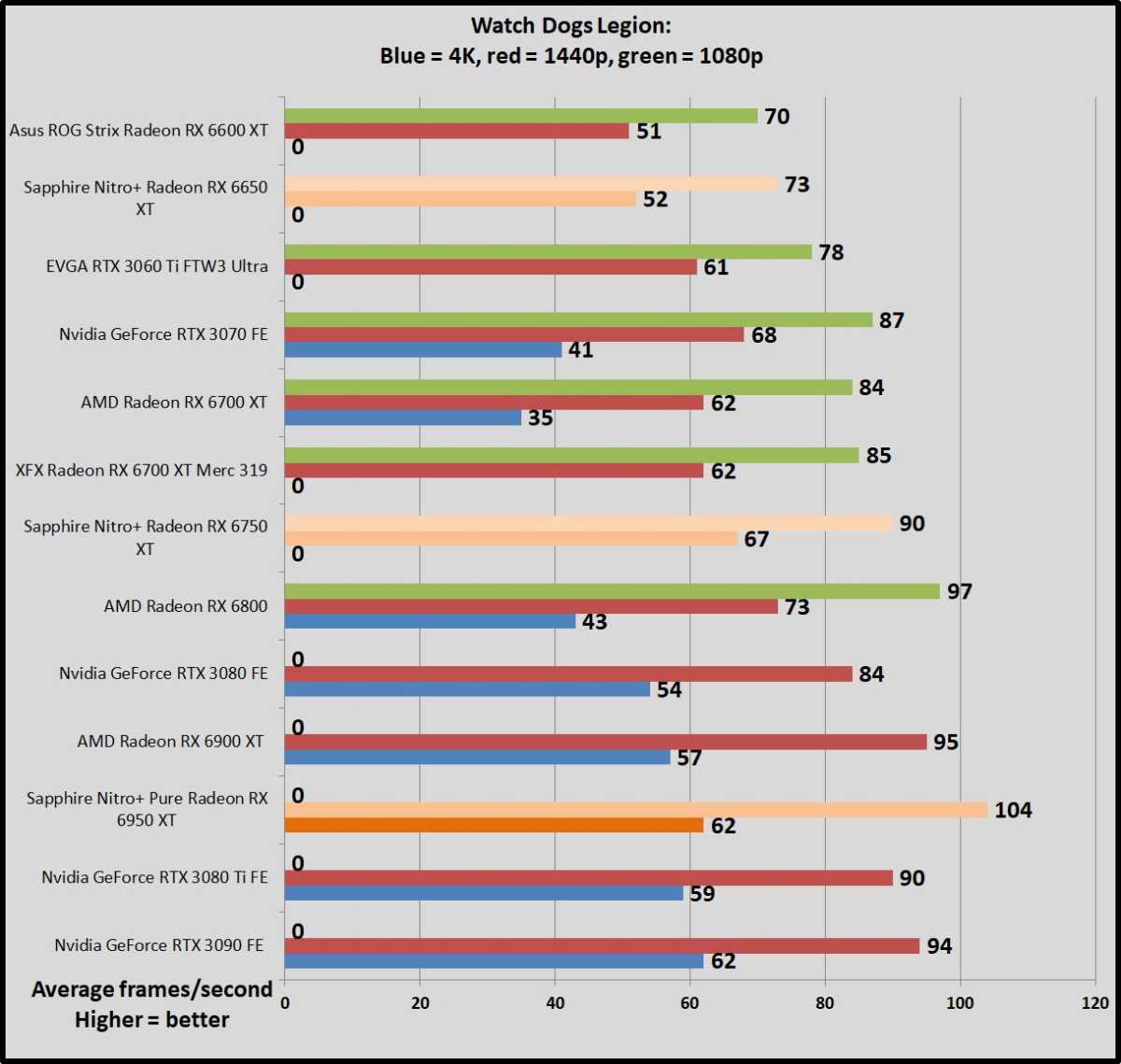
Brad Chacos/IDG
Brad Chacos/IDG
Brad Chacos/IDG
Horizon Zero Dawn
Yep, PlayStation exclusives are coming to the PC now. Horizon Zero Dawn runs on Guerrilla Games’ Decima engine, the same engine that powers Death Stranding.
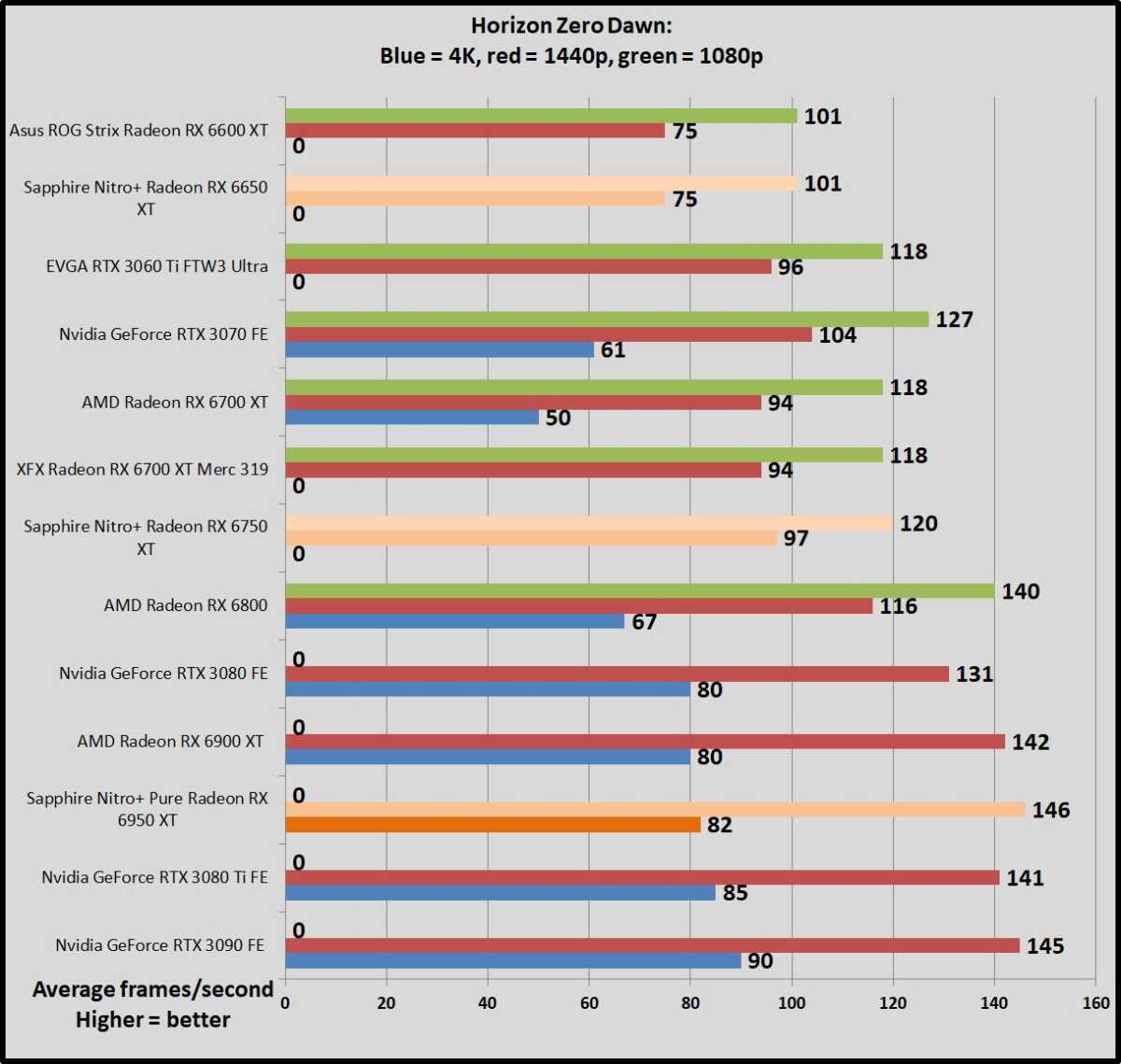
Brad Chacos/IDG
Brad Chacos/IDG
Brad Chacos/IDG
Gears Tactics
Gears Tactics puts it own brutal, fast-paced spin on the XCOM-like genre. This Unreal Engine 4-powered game was built from the ground up for DirectX 12, and we love being able to work a tactics-style game into our benchmarking suite. Better yet, the game comes with a plethora of graphics options for PC snobs. More games should devote such loving care to explaining what flipping all these visual knobs mean.
You can’t use the presets to benchmark Gears Tactics, as it intelligently scales to work best on your installed hardware, meaning that “Ultra” on one graphics card can load different settings than “Ultra” on a weaker card. We manually set all options to their highest possible settings.
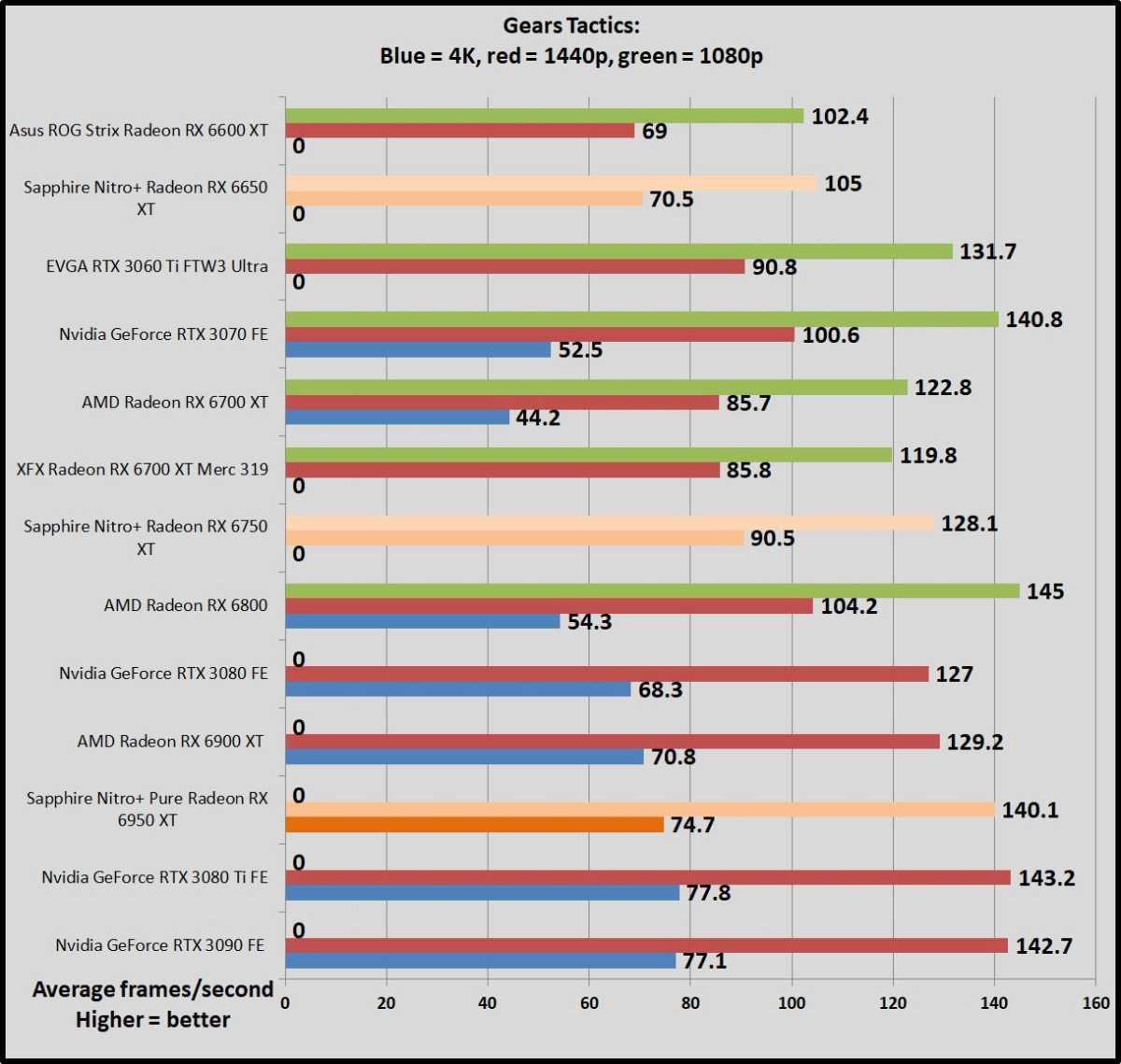
Brad Chacos/IDG
Brad Chacos/IDG
Brad Chacos/IDG
Wolfenstein: Youngblood
Wolfenstein: Youngblood is more fun when you can play cooperatively with a buddy, but it’s a fearless experiment—and an absolute technical showcase. Running on the Vulkan API, Youngblood achieves blistering frame rates, and it supports all sorts of cutting-edge technologies like ray tracing, DLSS 2.0, HDR, GPU culling, asynchronous computing, and Nvidia’s Content Adaptive Shading. The game includes a built-in benchmark with two different scenes; we tested Riverside.
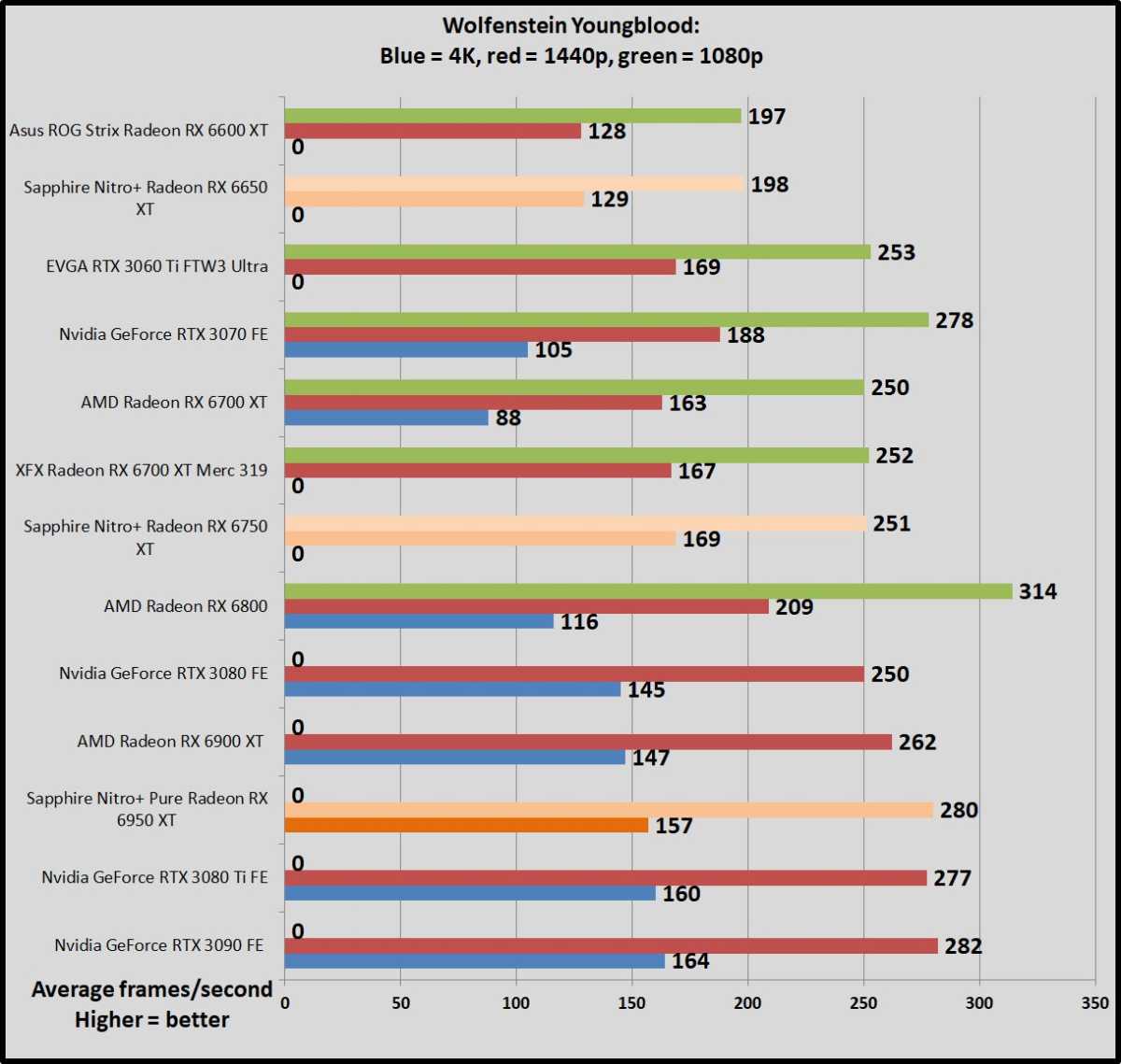
Brad Chacos/IDG
Brad Chacos/IDG
Brad Chacos/IDG
Metro Exodus
One of the best games of 2019, Metro Exodus remains one of the best-looking games around, too. The latest version of the 4A Engine provides incredibly luscious, ultra-detailed visuals, with one of the most stunning real-time ray tracing implementations released yet. The Extreme graphics preset we benchmark can melt even the most powerful modern hardware, as you’ll see below, though the game’s Ultra and High presets still look good at much higher frame rates.
We test in DirectX 12 mode with ray tracing, Hairworks, and DLSS disabled.
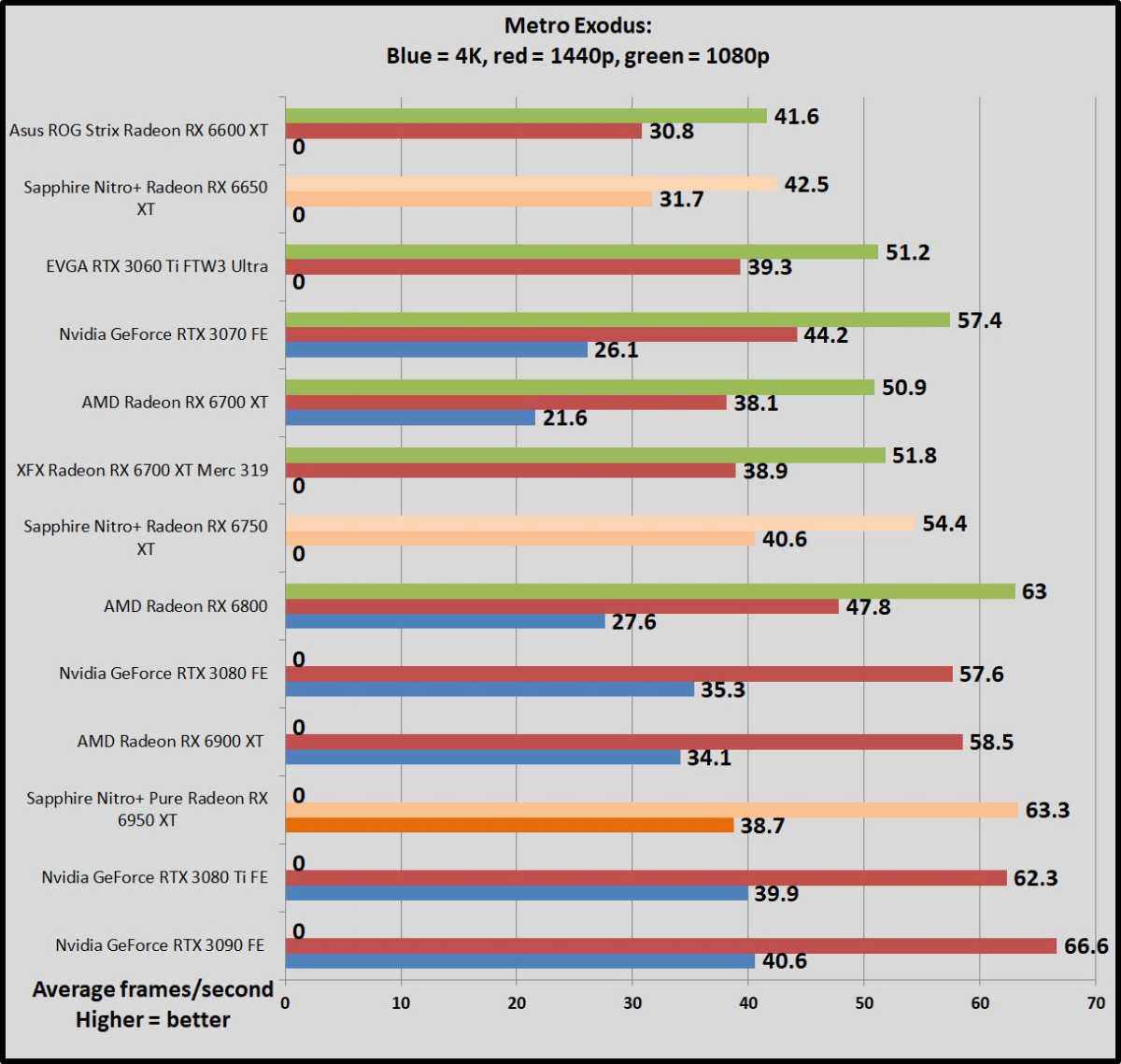
Brad Chacos/IDG
Brad Chacos/IDG
Brad Chacos/IDG
Borderlands 3
Borderlands is back! Gearbox’s game defaults to DX12, so we do as well. It gives us a glimpse at the ultra-popular Unreal Engine 4’s performance in a traditional shooter. This game tends to favor AMD hardware.
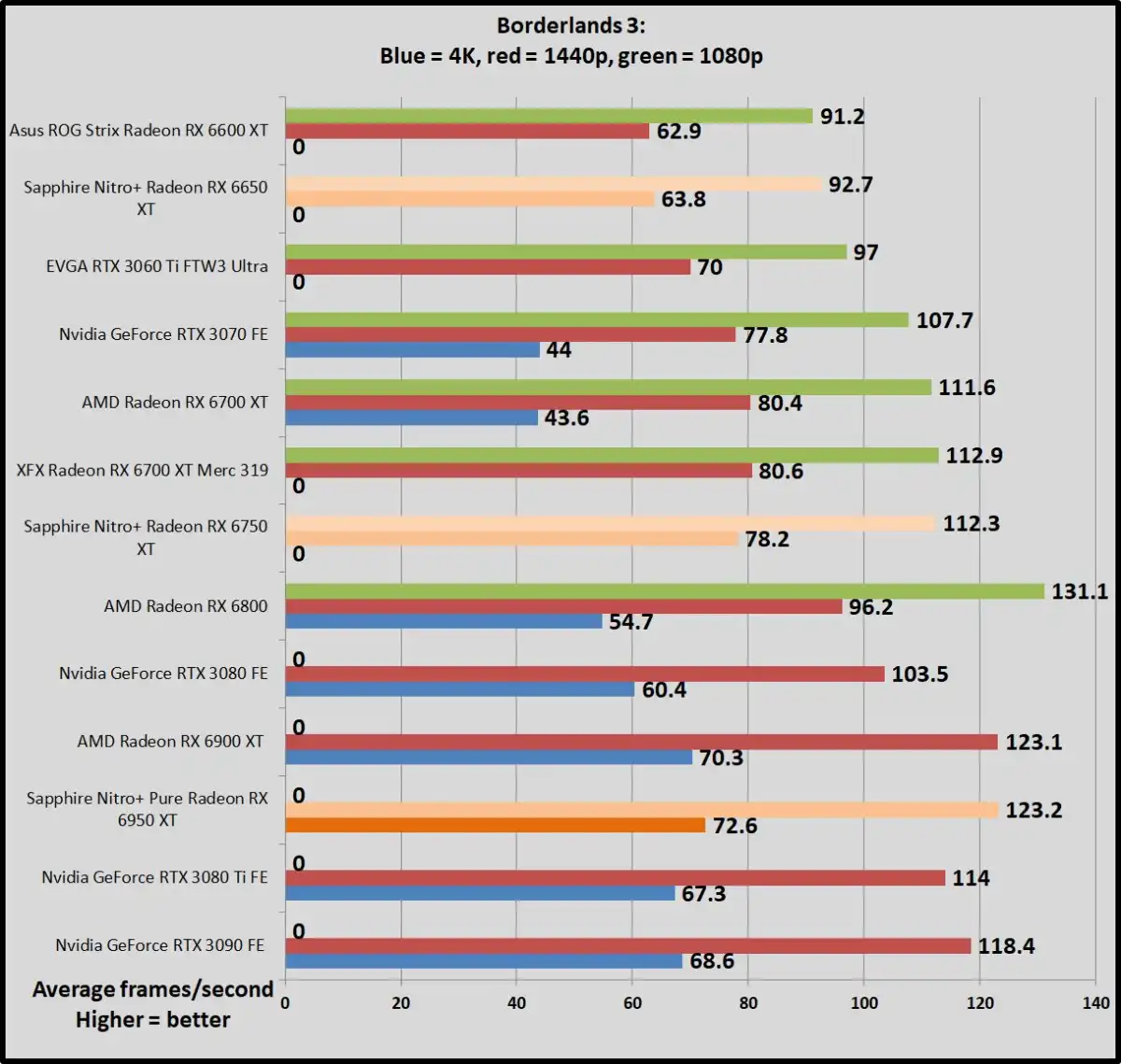
Brad Chacos/IDG
Brad Chacos/IDG
Brad Chacos/IDG
Strange Brigade
Strange Brigade is a cooperative third-person shooter where a team of adventurers blasts through hordes of mythological enemies. It’s a technological showcase, built around the next-gen Vulkan and DirectX 12 technologies and infused with features like HDR support and the ability to toggle asynchronous compute on and off. It uses Rebellion’s custom Azure engine. We test using the Vulkan renderer, which is faster than DX12.
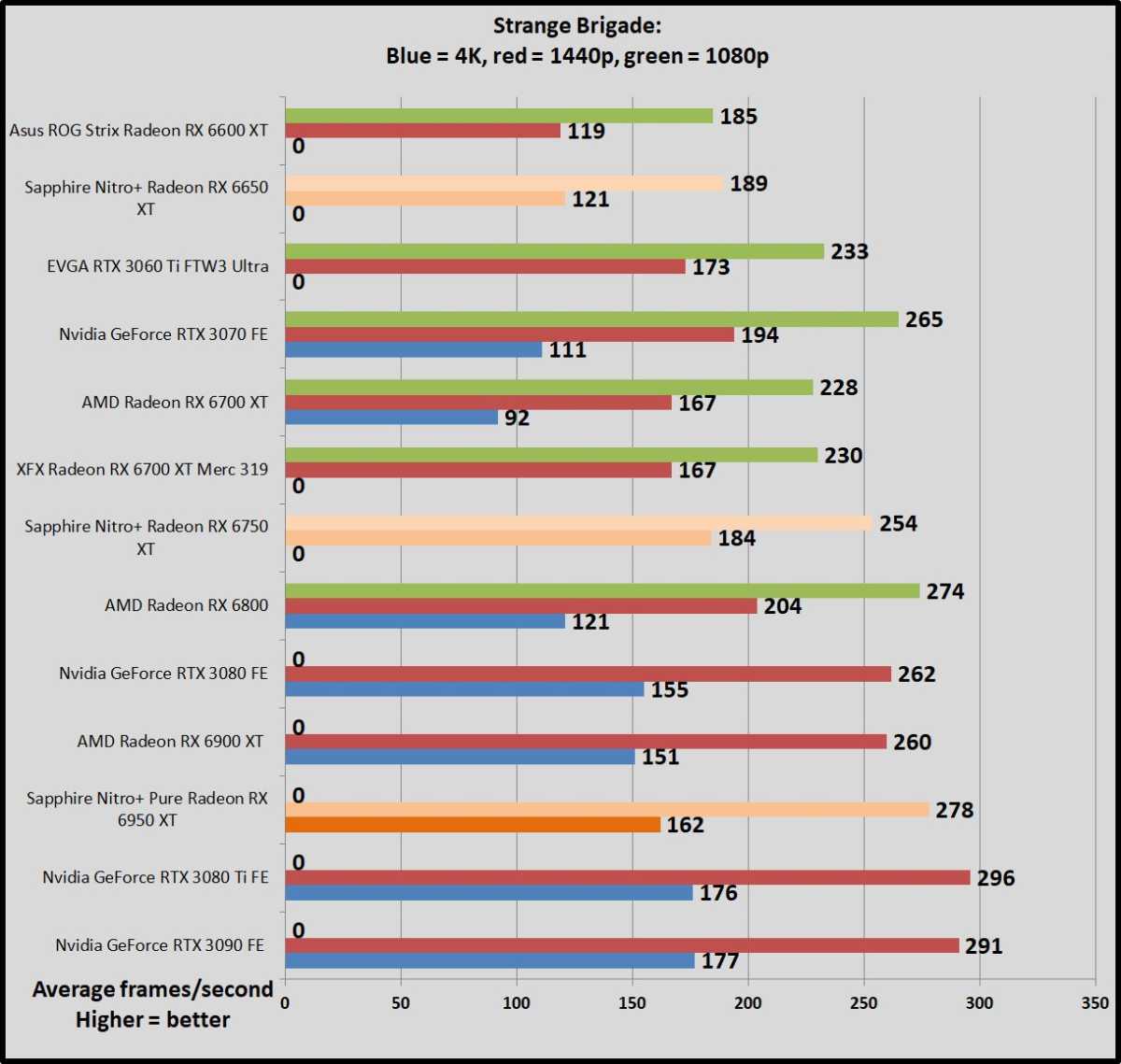
Brad Chacos/IDG
Brad Chacos/IDG
Brad Chacos/IDG
F1 2020
F1 2020 is a gem to test, supplying a wide array of both graphical and benchmarking options, making it a much more reliable (and fun) option than the Forza series. It’s built on the latest version of Codemasters’ buttery-smooth Ego game engine, complete with support for DX12 and Nvidia’s DLSS technology. We test two laps on the Australia course, with clear skies on and DLSS off.
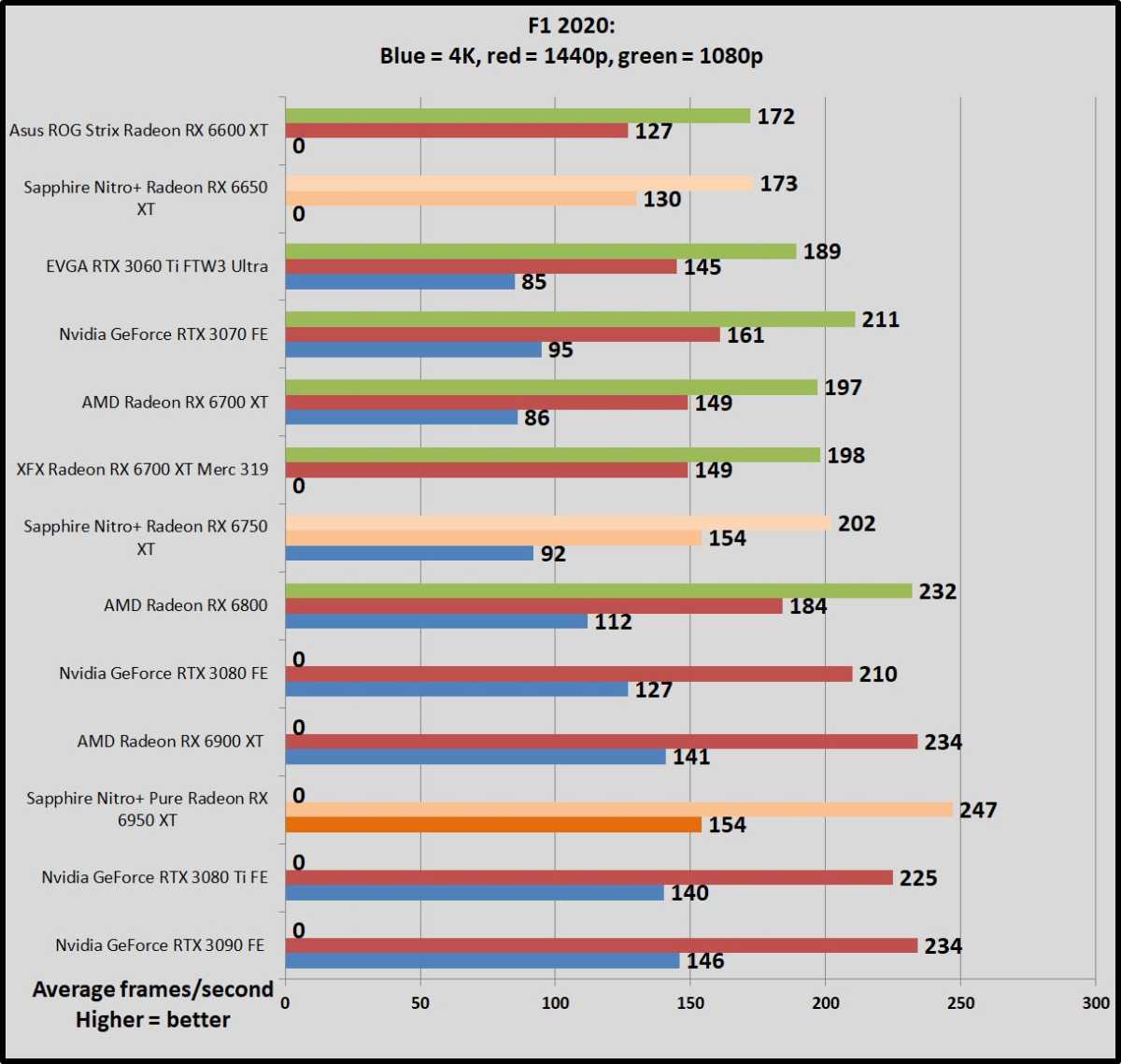
Brad Chacos/IDG
Brad Chacos/IDG
Brad Chacos/IDG
Shadow of the Tomb Raider
Shadow of the Tomb Raider concludes the reboot trilogy, and it’s still utterly gorgeous a couple of years after its debut. Square Enix optimized this game for DX12 and recommends DX11 only if you’re using older hardware or Windows 7, so we test with DX12. Shadow of the Tomb Raider uses an enhanced version of the Foundation engine that also powered Rise of the Tomb Raider and includes optional real-time ray tracing and DLSS features.
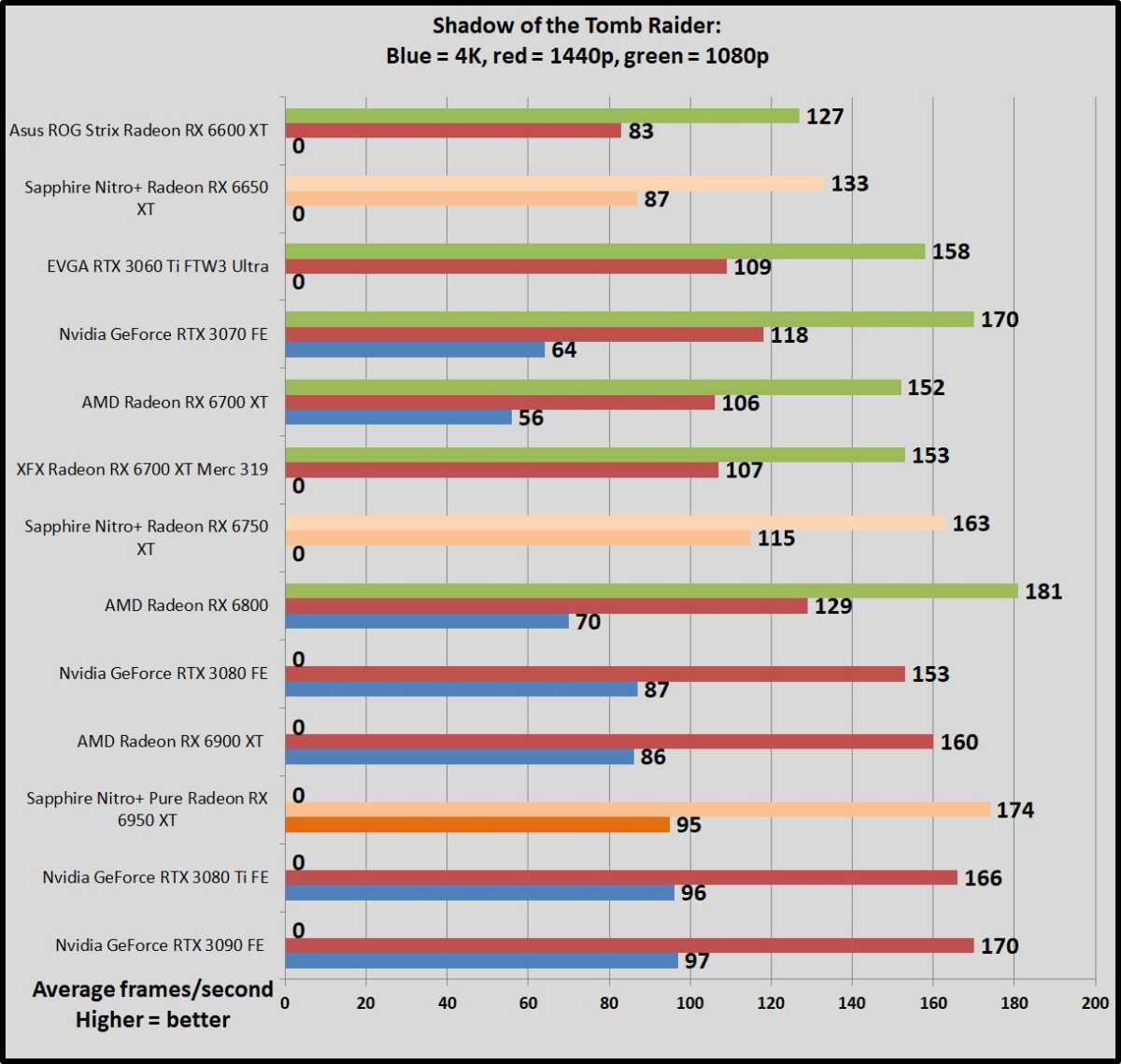
Brad Chacos/IDG
Brad Chacos/IDG
Brad Chacos/IDG
Rainbow Six Siege
Rainbow Six Siege still dominates the Steam charts years after its launch, and Ubisoft supports it with frequent updates and events. The developers have poured a ton of work into the game’s AnvilNext engine over the years, eventually rolling out a Vulkan version of the game that we use to test. By default, the game lowers the render scaling to increase frame rates, but we set it to 100 percent to benchmark native rendering performance on graphics cards. Even still, frame rates soar.
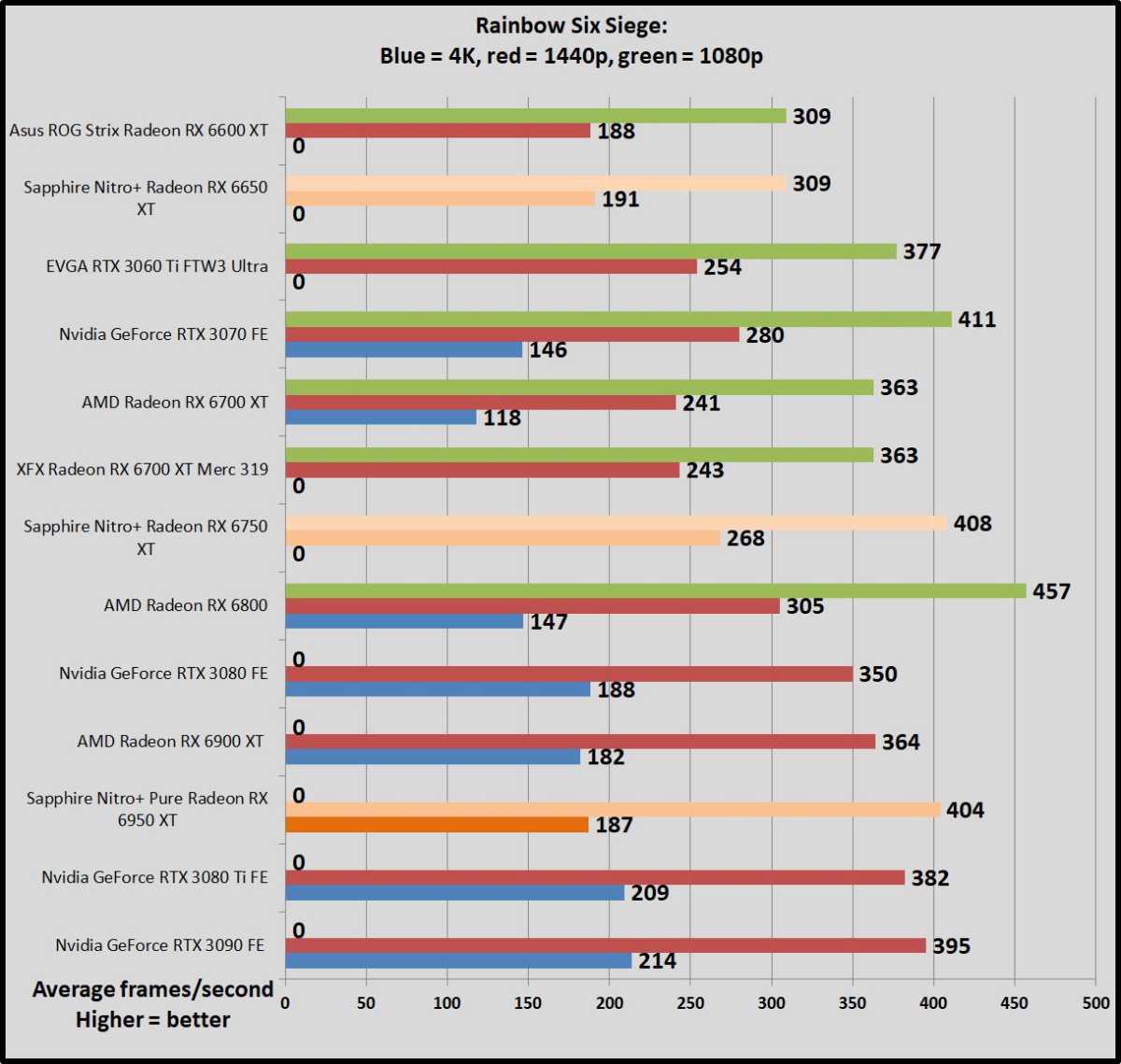
Brad Chacos/IDG
Brad Chacos/IDG
Brad Chacos/IDG
Radeon’s all-AMD advantage
Now that you know how the Radeon RX 6×50 refreshes perform in standard situations, it’s worth pointing out that AMD also offers software features that can significantly enhance performance in the right scenarios. AMD offers a wide range of performance-boosting features, but we’ll focus on two here: Smart Access Memory and Radeon Super Resolution.
If you also have an AMD Ryzen processor, Smart Access Memory lets it talk directly to your GPU’s full array of onboard memory, rather than limiting that communication to tiny chunks. Its effects vary wildly from game to game, and even from resolution to resolution or depending on what settings you’re using, but in general, SAM can provide an uplift in most games, especially newer ones built using the DirectX 12 or Vulkan graphics APIs. In rare scenarios, Smart Access Memory can provide double-digit speed increases. Nvidia and Intel support PCIe Resizable BAR, SAM’s underlying technology, but AMD’s custom solution is much more effective.
Next, there’s Radeon Super Resolution, which essentially lets RDNA GPUs use AMD’s killer FidelityFX Super Resolution tech in all games, not just games that actively integrate support. This upsampling technology isn’t as clean as Nvidia’s DLSS, but the ability to use it in every game is an amazing selling point that can’t be denied. Nvidia offers similar simple upscaling features beyond DLSS, but they’re far less polished and require jumping through more hoops.
RSR lets your Radeon GPU render games internally at a lower resolution, then upscales it to fit your monitor’s native resolution after, which lets you get the faster performance you’d expect from running at lower resolution, but with minimal quality loss. Well, mostly: While RSR and other upscaling techniques work exceptionally when you’re upscaling from 1080p to 1440p, or from 1080p or 1440p to 4K, upscaling 720p images to 1080p looks a bit more grainy, since it’s working with so many fewer pixels from the start. It definitely works for 1080p upscaling, but that nuance makes it a bit less attractive in 1080p-focused graphics cards like the Radeon RX 6650 XT.
Using either can give you a noticeable speed increase. Using both in tandem can propel these cards into new performance tiers. To give you a taste of just how effective SAM and RSR are as a duo, the charts below show the sorts of gains you get with SAM active on the Nitro+ Pure Radeon RX 6950 XT, and then with both SAM and RSR (upscaling from 1440p to 4K) enabled, alongside results from the RTX 3090. Compare the orange (SAM + RSR 1440p upscaled to 4K) bar against the blue 4K bars in the charts below, and be sure to notice how much—or little in the case of Metro Exodus—going from standard results to results with SAM on without RSR make in each game, at both 4K (blue) and 1440p (red) resolution.
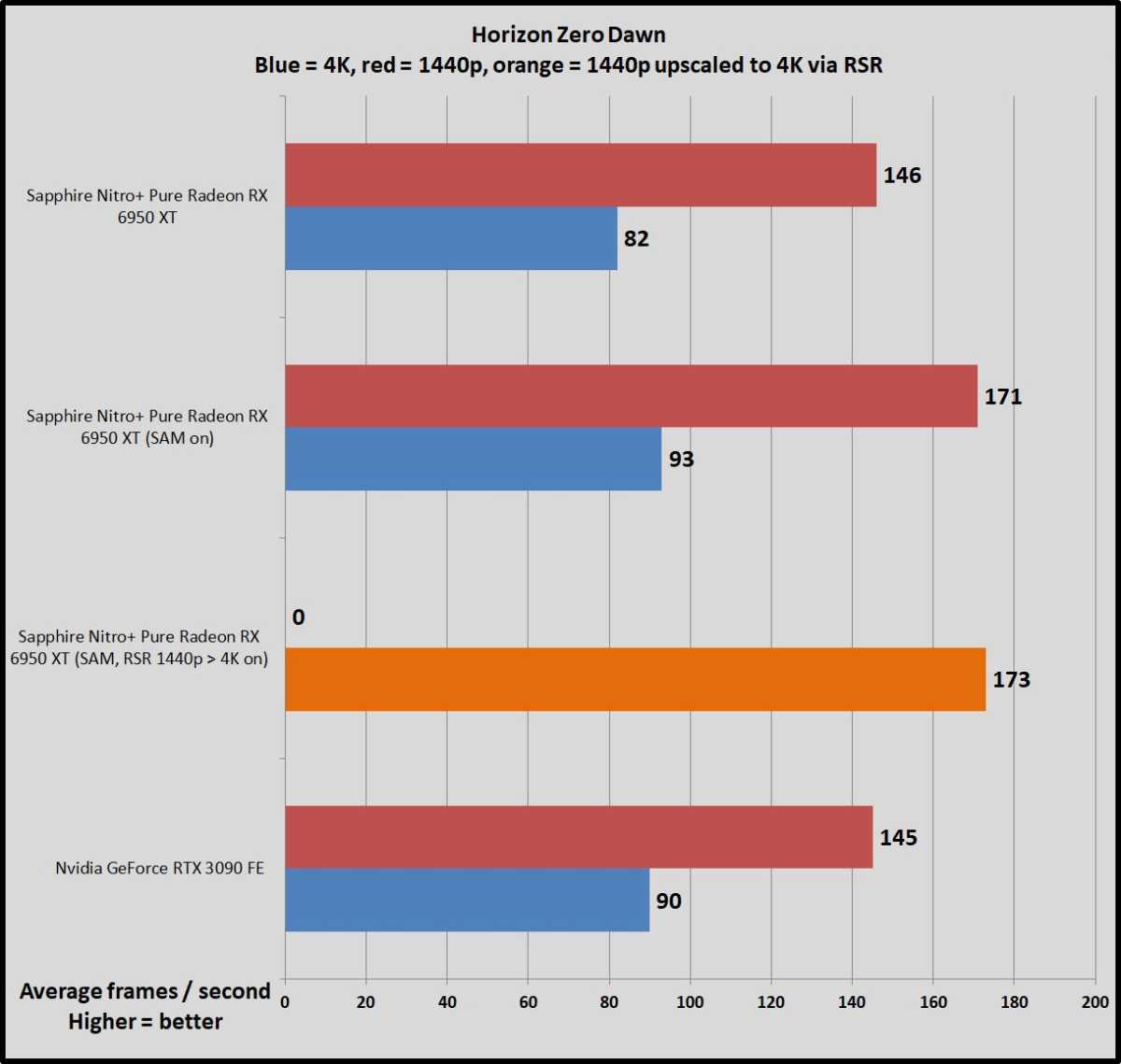
Brad Chacos/IDG
Brad Chacos/IDG
Brad Chacos/IDG

Brad Chacos/IDG
Brad Chacos/IDG
Brad Chacos/IDG
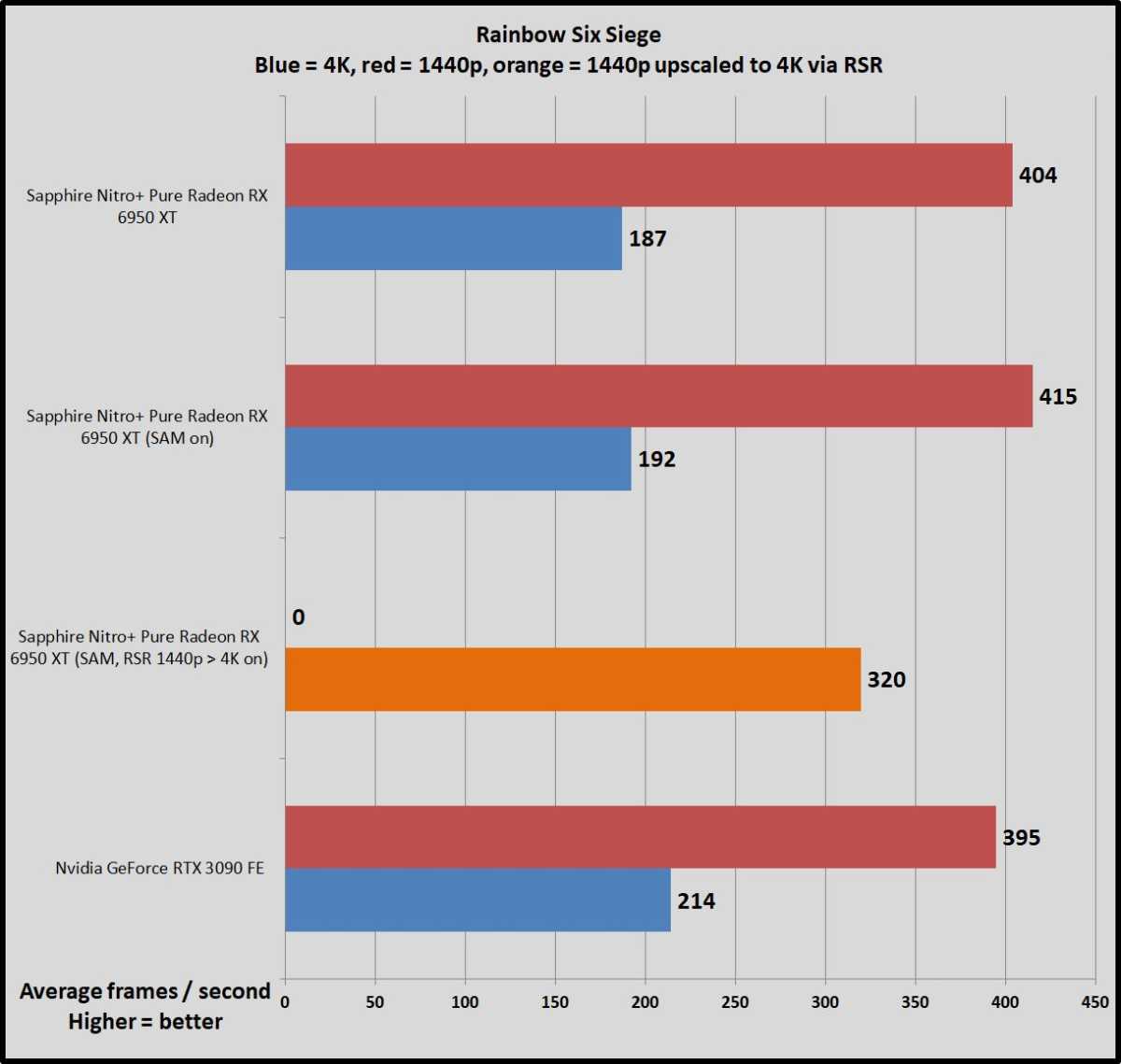
Brad Chacos/IDG
Brad Chacos/IDG
Brad Chacos/IDG
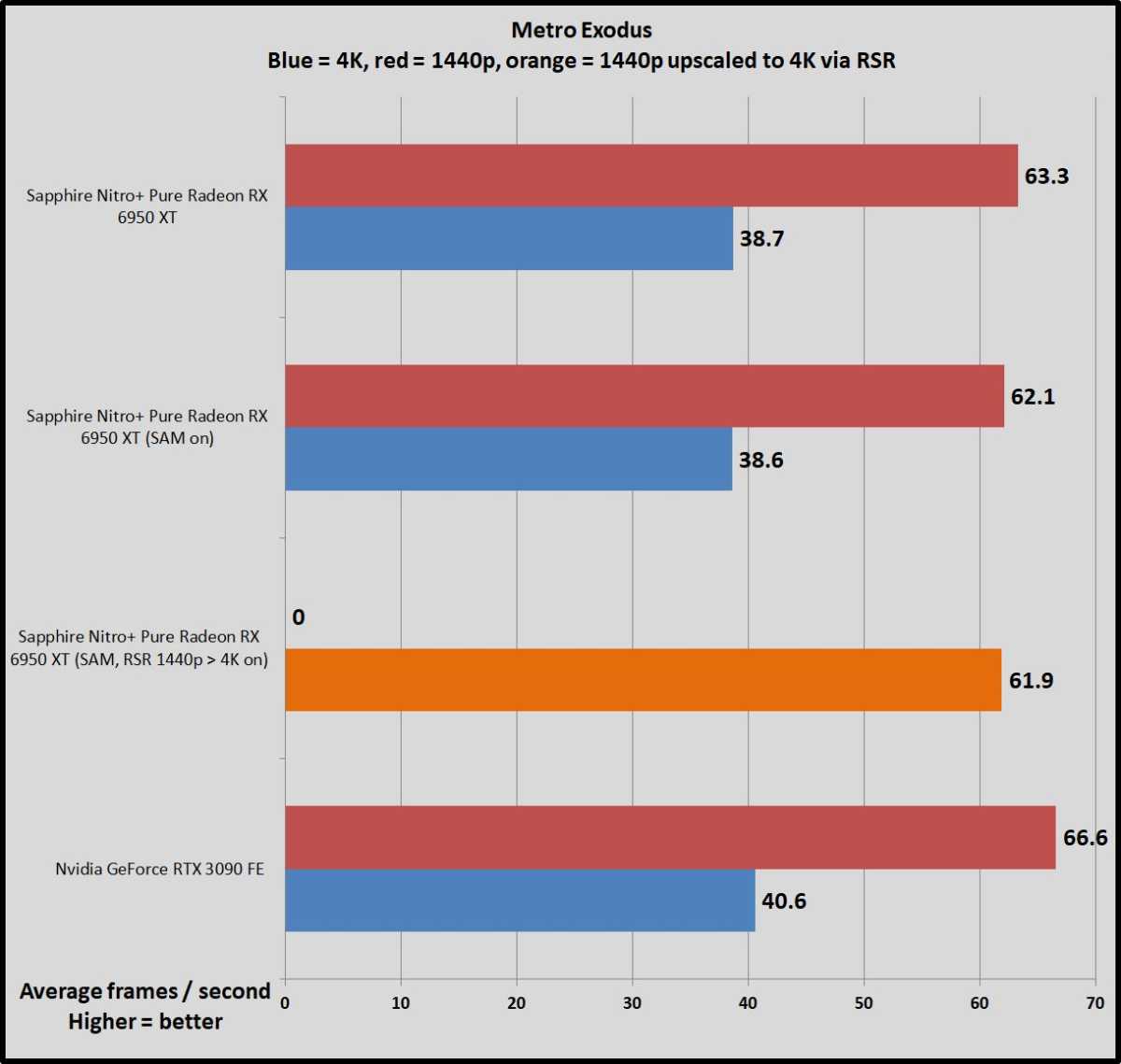
Brad Chacos/IDG
Brad Chacos/IDG
Brad Chacos/IDG

Brad Chacos/IDG
Brad Chacos/IDG
Brad Chacos/IDG
Sayonara, RTX 3090. There can be a slight image downgrade if you pause your games and pixel peep when upscaling from 1440p to 4K with RSR, especially in fine heads-up display elements, but it’s virtually imperceptible in motion.
Ray tracing performance
Remember that these Radeon RX 6×50 refreshes sport the same underlying GPUs as their vanilla versions. That means they don’t include additional hardware ray tracing units to try to close the gap in ray tracing performance between it and Nvidia’s GeForce RTX offerings, which are on their second generation of ray tracing tech.
We tested the Radeon RX 6650 XT and 6750 XT in a couple of games to confirm the fact. Watch Dogs: Legion packs ray-traced reflections, while Shadow of the Tomb Raider includes ray-traced shadows.
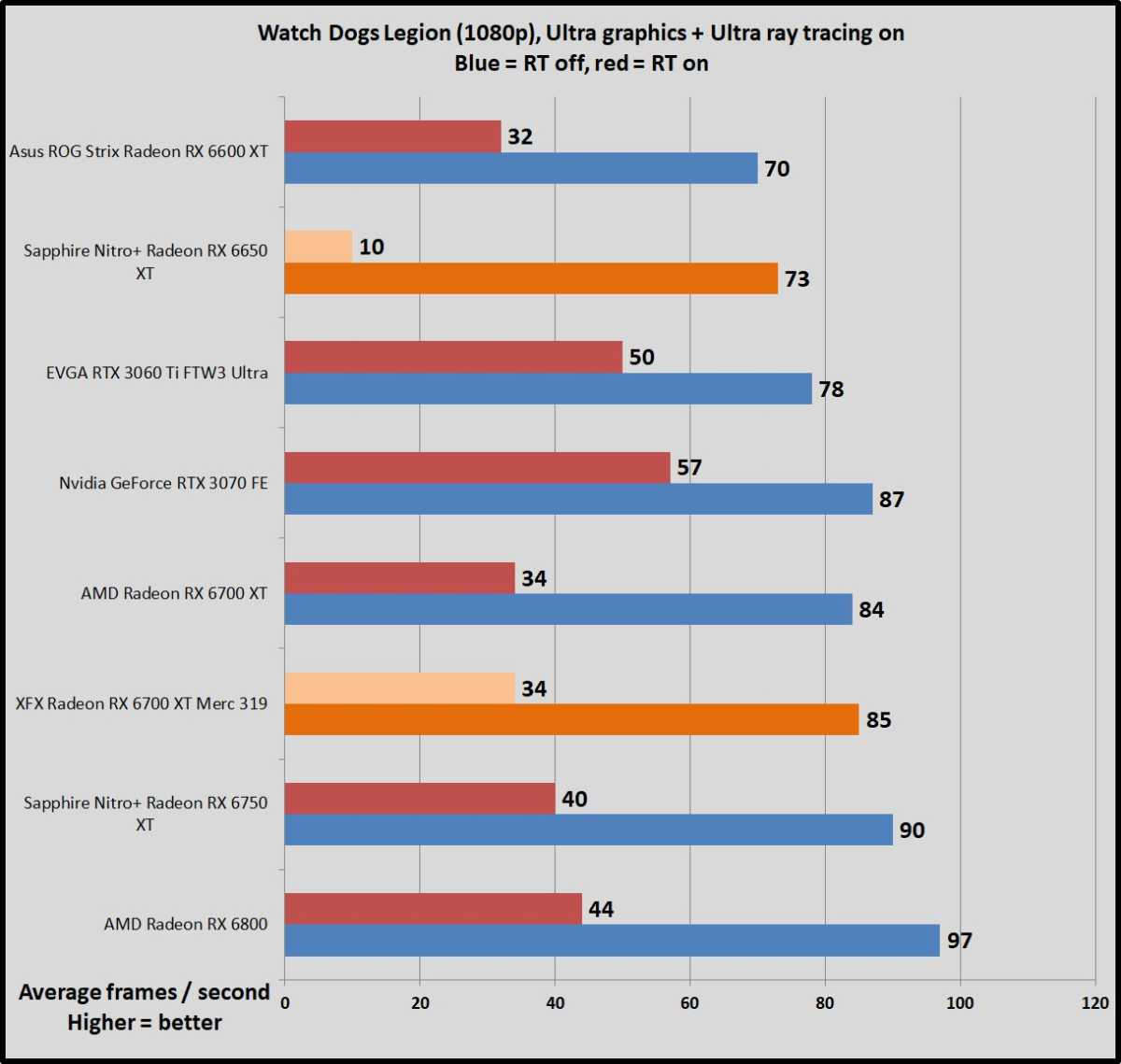
Brad Chacos/IDG
Brad Chacos/IDG
Brad Chacos/IDG

Brad Chacos/IDG
Brad Chacos/IDG
Brad Chacos/IDG
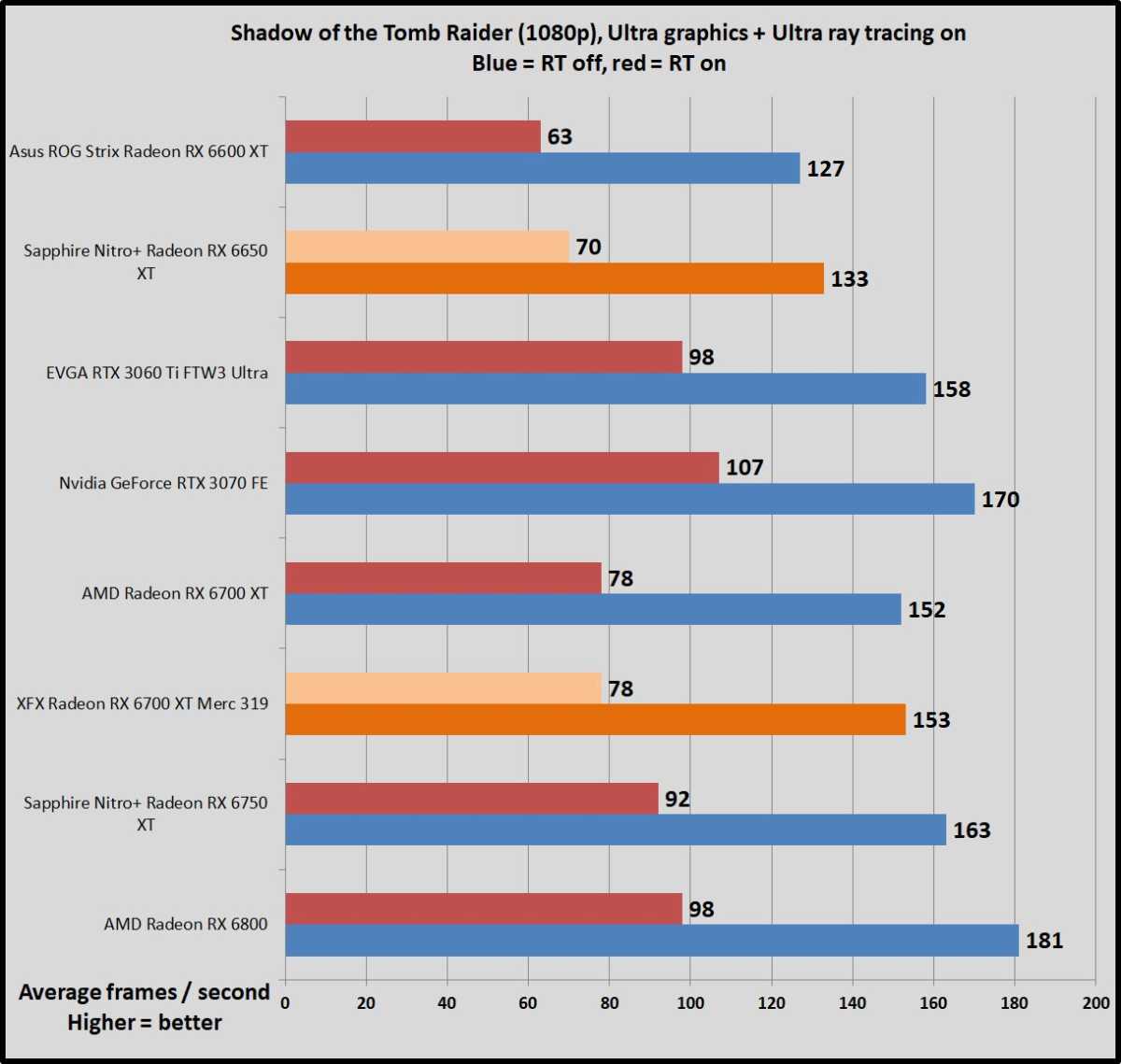
Brad Chacos/IDG
Brad Chacos/IDG
Brad Chacos/IDG

Brad Chacos/IDG
Brad Chacos/IDG
Brad Chacos/IDG
Yep: If peak performance in ray traced games is a major concern of yours, Nvidia’s GeForce RTX 30-series remains the best option by far. Other games include even more strenuous ray tracing effects (and combinations of effects) that would only exacerbate the gulf. That said, the ability to use Radeon Super Resolution to claw performance back in any ray-traced game is a noticeable feather in AMD’s cap.
Power draw, thermals, and noise
We test power draw by looping the F1 2020 benchmark at 4K for about 20 minutes after we’ve benchmarked everything else and noting the highest reading on our Watts Up Pro meter, which measures the power consumption of our entire test system. The initial part of the race, where all competing cars are on screen simultaneously, tends to be the most demanding portion.
This isn’t a worst-case test; this is a GPU-bound game running at a GPU-bound resolution to gauge performance when the graphics card is sweating hard. If you’re playing a game that also hammers the CPU, you could see higher overall system power draws. Consider yourself warned.
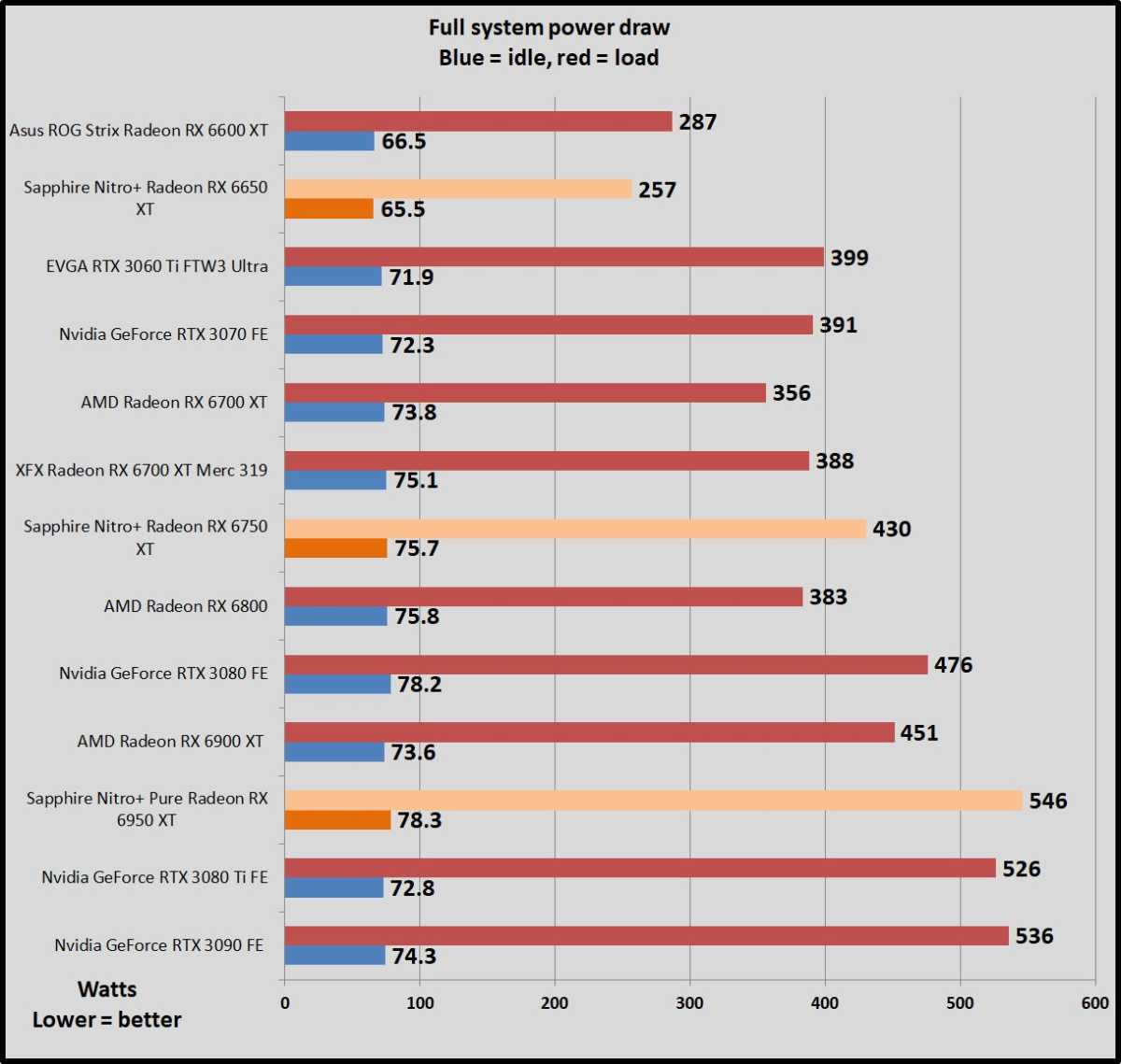
Brad Chacos/IDG
Brad Chacos/IDG
Brad Chacos/IDG
Pushing these GPUs’ clock and memory speeds even higher, and unleashing more energy to do so, results in noticeably higher power draws for the Radeon RX 6×50 refreshes. The Radeon RX 6750 XT and 6950 XT now suck down more juice than their primary Nvidia rivals, but the Radeon RX 6650 XT remains more conservative than the identically priced RTX 3060 Ti (though the 3060 Ti is much faster in performance as well).
We test thermals by leaving GPU-Z open during the F1 2020 power draw test, noting the highest maximum temperature at the end.
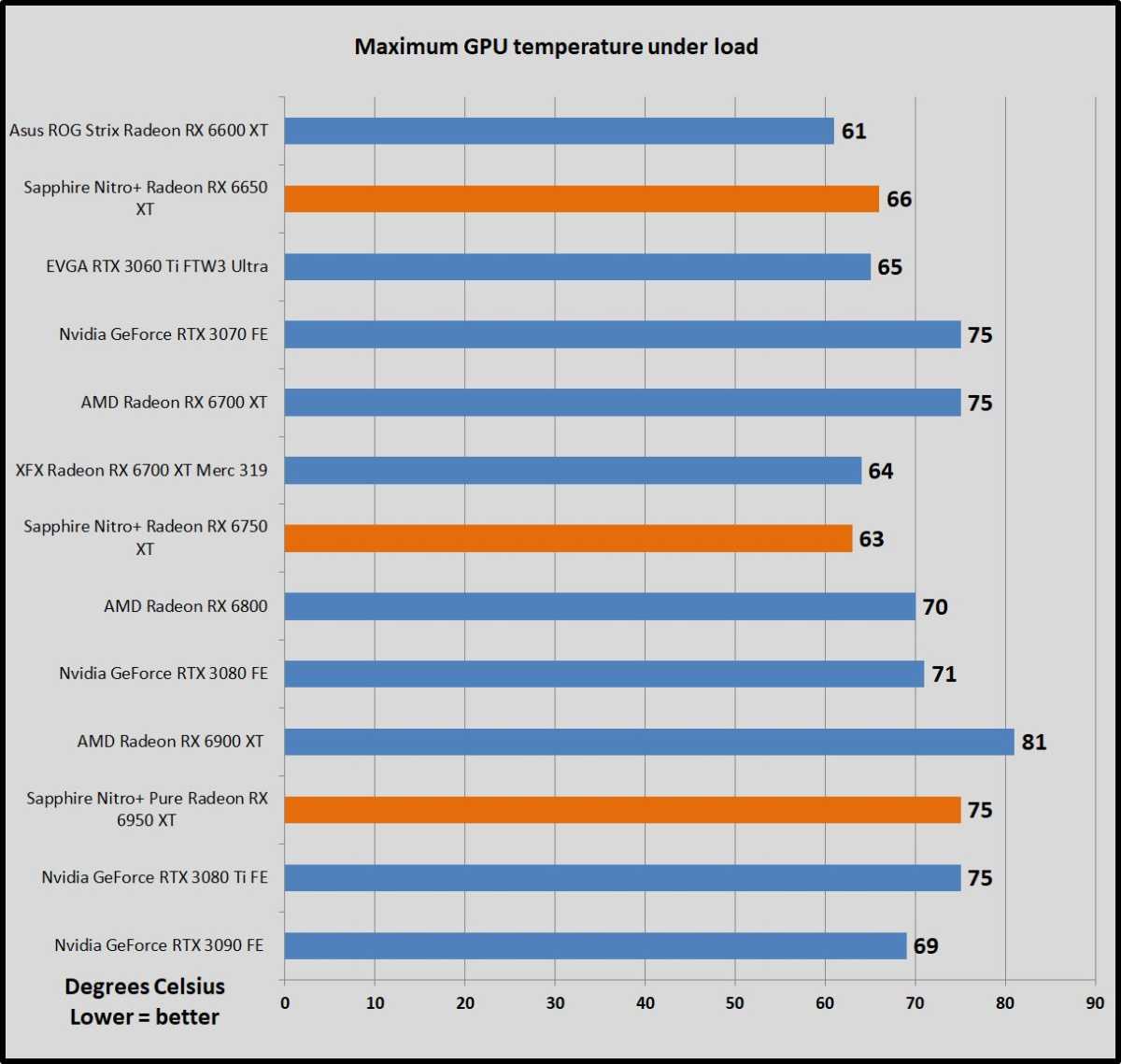
Brad Chacos/IDG
Brad Chacos/IDG
Brad Chacos/IDG
Sapphire’s cooling prowess proves itself once again. All three of these Nitro+ GPUs stay cool and whisper-quiet even under massive load. They aren’t quite silent, but they’re damned near it, especially enclosed in a case. And remember that they are silent during non-gaming desktop use thanks to Sapphire’s idle fan-stop feature.
Conclusion
So the dust has cleared and the benchmarks have been run. Should you buy these Radeon RX 6×50 refreshes? It depends.

Brad Chacos/IDG
Brad Chacos/IDG
Brad Chacos/IDG
The power, clock, and memory speed increases boost performance a decent amount for all these cards, but not by earth-shattering amounts. Graphics card pricing is finally approaching MSRP after two long, bleak years of shortages, but the changes here are nuanced enough that it doesn’t change our underlying impressions of each core GPU. We originally said the Radeon RX 6600 XT and 6700 XT deliver good performance for 1080p and 1440p gaming, respectively, but come with too-high price tags. These 6650 XT and 6750 XT offerings are a little bit faster and cost even more. Their release doesn’t effectively alter the value proposition of the Radeon lineup, even though the move to more power negates AMD’s efficiency advantage over Nvidia’s RTX 30-series.
The spectacular $400 GeForce RTX 3060 Ti still serves as a big spoiler for both of these new Radeon GPUs. It is significantly faster than the Radeon RX 6650 XT for the same price, and often only a bit slower than the $550 Radeon RX 6750 XT (which trades blows with the $500 RTX 3070). In AMD’s press briefing, the company made the point that the cheapest street pricing for the Nvidia GPUs put them at $579 for the 3060 Ti and $770 for the RTX 3070—but then lists its own 6×50 refreshes at MSRP.
If these new Radeon offerings stick to MSRP, while Nvidia’s remain inflated, AMD’s cards are the better buy (especially if you plan on using Smart Access Memory and Radeon Super Resolution). But GPU prices keep creeping downward. If Nvidia’s rivals become available near MSRP, the RTX 3060 Ti remains the clear champion of this entire segment, especially given GeForce’s strong ray tracing and DLSS advantages. We haven’t seen the RTX 3060 Ti going for anywhere near $400 yet, though.
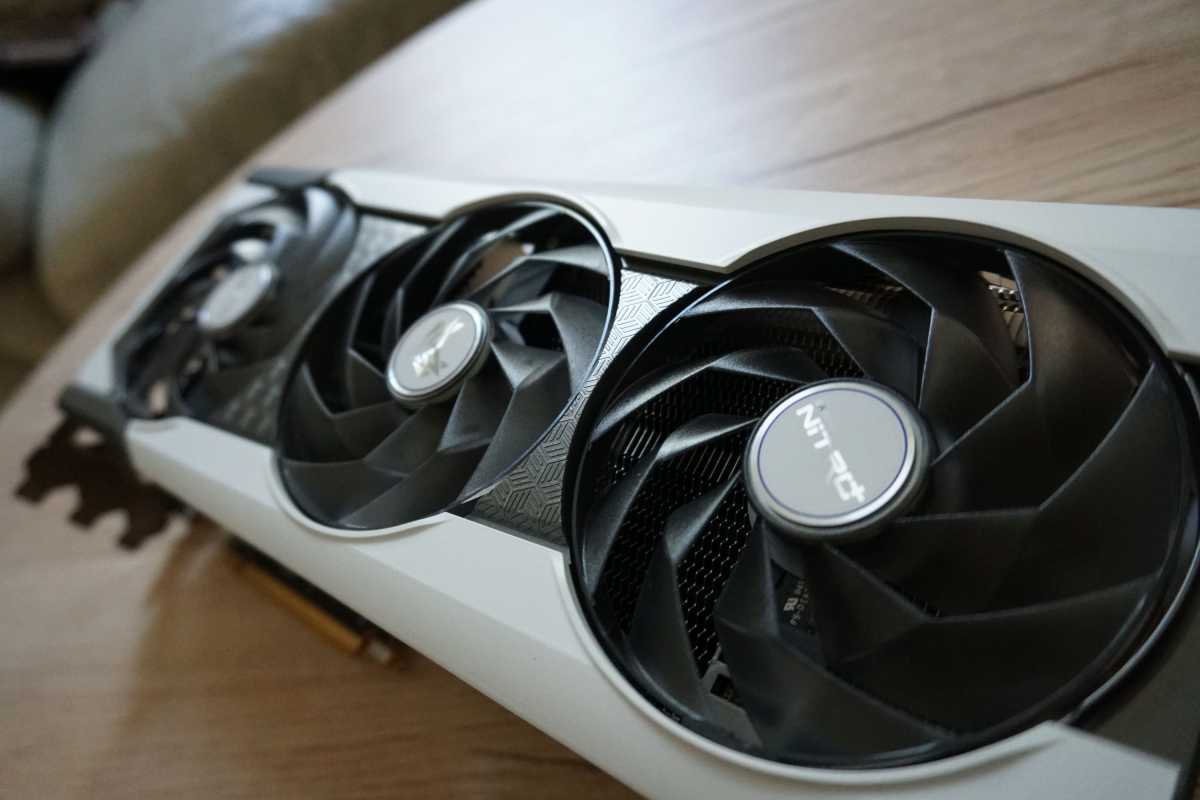
Brad Chacos/IDG
Brad Chacos/IDG
Brad Chacos/IDG
The Radeon RX 6950 XT is more interesting. The vanilla 6900 XT traded blows with the GeForce RTX 3090, and the supercharged Radeon RX 6950 XT meets or beats Nvidia’s monster in the vast majority of titles, especially if you play at lower 1440p or 1080p resolutions that let RDNA 2’s Infinity Cache flex its muscles. If you have a Ryzen rig capable of using Smart Access Memory, the scales tip even more in AMD’s favor. And if you plan on using Radeon Super Resolution to upscale games from 1440p to 4K—since RSR works universally—it utterly smokes the RTX 3090 (and 3080 Ti) with almost no perceptible downgrade in visual fidelity. Giddy-up.
That said, splurging on a $1,000-plus graphics card for gaming prowess alone is pretty niche. The GeForce RTX 3090’s massive 24GB memory buffer and ray tracing capabilities make it the clear choice for content creators who want to work and play on their GPU. When it comes to the similarly ferocious $1,200 RTX 3080 Ti, which costs $100 more than the 6950 XT, we’d recommend picking your poison based on available features. Do you prefer the enhanced ray tracing and DLSS capabilities of GeForce, which only work in select cutting-edge games, or AMD’s killer duo of Smart Access Memory and Radeon Super Resolution, which work to some degree in virtually all games? Personally, we’d probably lean towards the latter (running 4K games at 1440p speeds with little-to-no visual downgrades rocks) but there’s no right or wrong answer.

Brad Chacos/IDG
Brad Chacos/IDG
Brad Chacos/IDG
Finally, if you decide to pick up one of AMD’s new cards and are willing to spend a bit more for a high-end custom version, we can’t recommend Sapphire’s Nitro+ models highly enough, just like we have been for years. They’re attractive, fast, cool, and quiet, with features that PC gaming enthusiasts demand, like dual BIOS switches and RGB lighting. Sapphire makes excellent products, full stop. Yes, Nitro+ cards charge a premium for their prowess, but they’re worth it.
And if you’re in the market for a god-tier graphics card, take a long, hard look at the Nitro+ Pure Radeon RX 6950 XT in particular. The new design tames this hotrod GPU in spectacular fashion, and with its standout all-white, all-aluminum design, looks absolutely fantastic doing so. This may be the most enjoyable graphics card I’ve benchmarked this generation. I can’t wait to tinker with its OC BIOS and open up the power limits even more.
Editor’s note: Our content system only allows for one scored review per article. The Nitro+ Radeon RX 6650 XT and Nitro+ 6750 XT would get 3.5 stars—3 for AMD’s underlying GPU performance, and an extra half star for Sapphire’s sublime Nitro+ design and implementation.
Best Prices Today: Nitro+ Pure Radeon RX 6950 XT
RetailerPrice
Author: Brad Chacos, Executive editor

Brad Chacos spends his days digging through desktop PCs and tweeting too much. He specializes in graphics cards and gaming, but covers everything from security to Windows tips and all manner of PC hardware.
Recent stories by Brad Chacos:
Nvidia GeForce RTX 4080 Super review: The 4K graphics card you wantNew Arc drivers provide huge DX11 performance boost for Intel GPUsAudio Radar gives hearing impaired gamers a fair shot





